|
Warning, there are photos of dead or injured people on this page. If the viewer is sensitive to this, this page should not be viewed. Unless otherwise stated, picture source: NARA |
Website translated from German with DeepL.com

English |
The shredded corpse of Katharina Esser |

Deutsch |
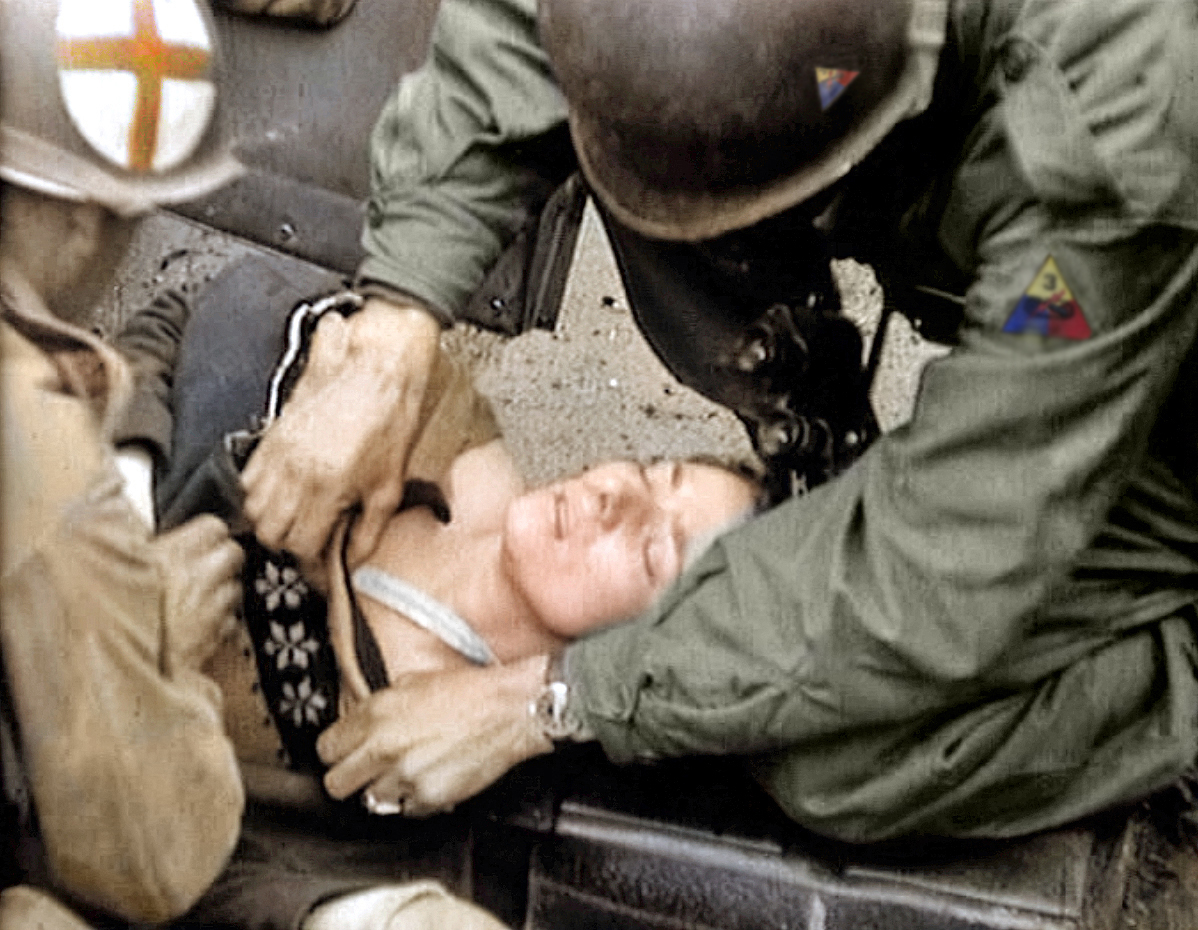
Katharina Esser
 | Here you can find a sub-page with a short version of this very detailed page here. |
The prehistory
Cologne, March 6, 1945. It is around 11:00 a.m. when the advancing US troops approach the Kaiser-Wilhelm-Ring and thus the inner city area, coming from the Subbelrather Strasse via the Gladbacher Strasse. Standing on Gladbacher Strasse, they can already see across Kaiser-Wilhelm-Ring to Christophstrasse (white arrow) and the church of St. Gereon (black arrow).

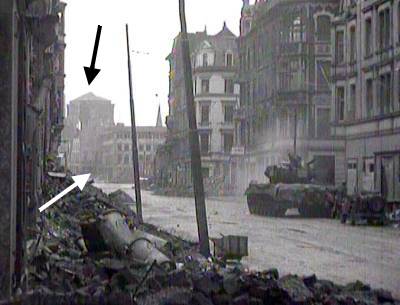
In the area of Christophstrasse, a German Panzer IV is standing at this time and firing in the direction of the advancing US troops. This German tank was supposed to drive to the Gereon freight station, after it had come from the other side of the Rhine over the Hohenzollern bridge only in the morning. However, it is now already here, shortly before its actual destination, facing the advancing US troops.
The US troops are also firing across to the German side and in particular the German tank. Particularly involved is a Pershing-type tank whose 19-year-old gunner is a young man named Clarence Smoyer.
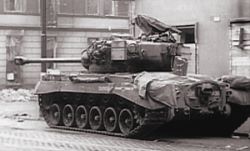
 The Pershing-type tank advancing with the troops. Still a fairly new tank model, it is the focus of interest for the cameramen advancing with the troops. In the case of the units on Gladbacher Strasse, these are the film cameramen Jim Bates and Leon Rosenmann. Later in the day, they will be filming the famous tank duel at the cathedral. The Pershing-type tank advancing with the troops. Still a fairly new tank model, it is the focus of interest for the cameramen advancing with the troops. In the case of the units on Gladbacher Strasse, these are the film cameramen Jim Bates and Leon Rosenmann. Later in the day, they will be filming the famous tank duel at the cathedral.
One of them uses the telephoto lens of his camera and films the side still in German hands in close-up. In the film images created in this situation, a person can be seen standing by a car on the opposite Christophstrasse, i.e. on the - still - German side. This person is at the side, presumably at the slightly opened passenger door of the car and closes it at the end of the short scene. Possibly this car had been shot at and hit during the fighting (which is not visible in the film) and this person now wants to help the passengers in the car or has even been a passenger himself and then got out - the door on the other side - probably the driver's door - is wide open. So now the person possibly looks for a possibly existing occupant. However, the person closes the door. Using video editing software, I enlarge and edit a section of the original movie frame. The short video created can be viewed below:
A close-up shot of this car taken later, shows why the man probably closes the door again. 
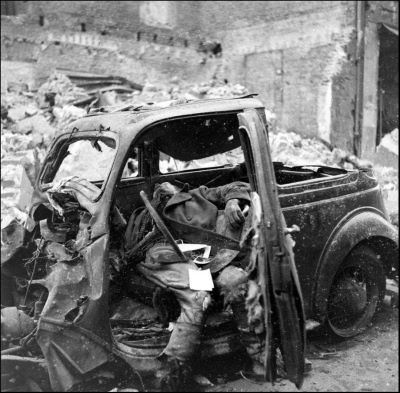
photo source: John Florea - LIFE Photo Collection
 The driver of the car is beyond help, lying dead in the driver's seat. The driver of the car is beyond help, lying dead in the driver's seat.
The vehicle had obviously come from the Dresden area, as the license plate visible on another picture reveals :
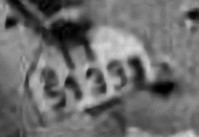
 The first two digits "II" stand for this regional assignment. It is also not a military but a private vehicle. The first two digits "II" stand for this regional assignment. It is also not a military but a private vehicle.
In the further temporal course (the above-mentioned man was now no longer at the car) a civilian car coming from the direction of Hansaring and entering the Christophstrasse suddenly gets between the front lines during a filming. Clarence Smoyer, the Pershing's gunner, mistakes it for a military vehicle and immediately fires at it. The car is hit and rolls out to the side of Christopher Street. A short video of this film clip can be accessed below:
The driver of this civilian vehicle is shot in the head and dies instantly. He is accompanied in the car by a young woman. The latter is also so severely wounded in the course of the shelling that she is unable to flee from the car.
The following 3-picture sequence shows a shelling of the car by the US troops. The specific projectile can be easily identified by the tracer beam in the two left images (black arrows). In the rightmost picture it hits the car in the rear area (white arrow), possibly this is the hit that injures the young woman on the passenger seat 
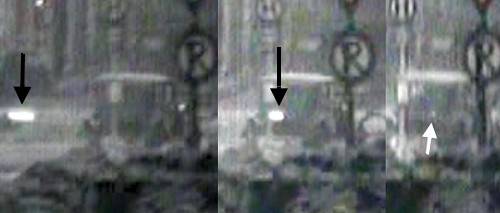
It cannot be excluded that at the same time the car came into the field of fire of the German Panzer IV and received an accidental hit from there. Gustav Schäfer, the machine gunner of Panzer IV at the time, who was interviewed on the DVD, does not consider it impossible that the car was also hit when it came between the fronts.
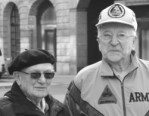
 The MG gunner of the Panzer IV, 18-year-old Gustav Schäfer (left), deceased in 2017, and the gunner of the Pershing, 19-year-old Clarence Smoyer, deceased in 2022, at a meeting in Cologne in 2013. The MG gunner of the Panzer IV, 18-year-old Gustav Schäfer (left), deceased in 2017, and the gunner of the Pershing, 19-year-old Clarence Smoyer, deceased in 2022, at a meeting in Cologne in 2013.
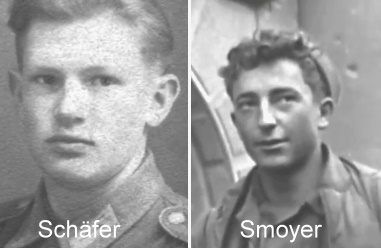
 The two shooters in wartime. Source: Adam Makos The two shooters in wartime. Source: Adam Makos
In any case, the fighting continues even after the car has been fired upon. The car is in the middle of the fronts the entire time, in the middle of the bullets flying around.

 The film images show that the passenger door is open. At this point, the young woman is obviously still sitting in the car, right next to the dead driver, because the body is not - as will be seen in the later shots (right image) - lying below the open door. This can be seen well on the left picture. The film images show that the passenger door is open. At this point, the young woman is obviously still sitting in the car, right next to the dead driver, because the body is not - as will be seen in the later shots (right image) - lying below the open door. This can be seen well on the left picture.
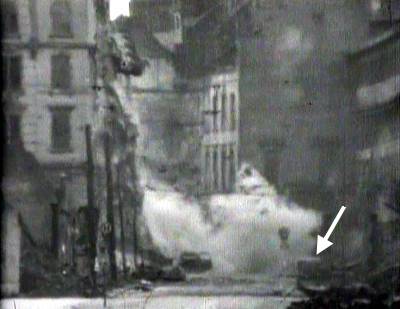
 The US troops let their lead tank, the Pershing, shoot at the house fronts of Christophstrasse in order to hit or bury the German Panzer IV. The young woman's car is still parked on the right side of the street (white arrow) during this fighting or shelling by the US troops. The US troops let their lead tank, the Pershing, shoot at the house fronts of Christophstrasse in order to hit or bury the German Panzer IV. The young woman's car is still parked on the right side of the street (white arrow) during this fighting or shelling by the US troops.
Not visible in the film, but the house facade on the corner of Christophstrasse and Von-Werth-Strasse, which is still visible on the left, will collapse too when the shelling continues; it is even closer to the car and will certainly cause a cloud of dust to drift towards the car when it collapses.

 Left side, in the background a house facade is already falling onto the street, on the left there is still a house facade - red arrow. Right side, later, the soldiers are already advancing towards the ring road, the house front has collapsed in the meanwhile, it is away - red arrow. Red circles, the car that was shot at. Left side, in the background a house facade is already falling onto the street, on the left there is still a house facade - red arrow. Right side, later, the soldiers are already advancing towards the ring road, the house front has collapsed in the meanwhile, it is away - red arrow. Red circles, the car that was shot at.
At the time of the shelling of the houses, the passenger falls from her seat directly onto the road next to the passenger side. It remains unclear whether it is her serious injury that causes her to simply fall out of the car or whether she is afraid of the collapsing house facades and drops down next to the car. In any case, you can already see her lying next to the car. She remains in this position until the Americans have moved up to her later.

 Picture above, during the shelling of the houses the woman is lying next to the car, you can see her head and dark body including her legs under the car. This is exactly how she lies next to the car when the US soldiers arrive later, picture below. Picture above, during the shelling of the houses the woman is lying next to the car, you can see her head and dark body including her legs under the car. This is exactly how she lies next to the car when the US soldiers arrive later, picture below.
The turret of the Panzer IV can no longer be turned correctly due to the falling debris from the shelled houses. The commander decides that the tank will withdraw. Its radio operator Gustav Schäfer reports to me that the tank did not go far for this. Together with the commander he then left the tank and hides in a cellar. He remembers to have read the writing "Hotel Gereon" on a house. From these descriptions one can draw the conclusion that he left the tank in Probsteigasse (at the corner of which there was still a Hotel Gereon in more recent times), about 100 to 150 meters behind the last firing position. The remaining crew, however, apparently continues with the tank. When Schäfer later comes to the street, the Panzer IV is no longer there.
In another close-up, a passerby can be seen crossing street Von-Werth-Strasse. He, too, is fired upon directly by the US troops, but is apparently able to reach the other side of the street unharmed. This film clip can be viewed below.
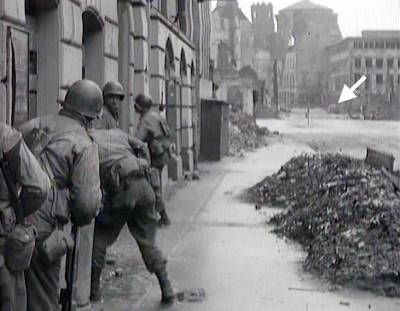
 The soldiers slowly advance to street Kaiser-Wilhelm-Ring. In the background, standing in Christophstrasse, is the car of the injured young woman. The soldiers slowly advance to street Kaiser-Wilhelm-Ring. In the background, standing in Christophstrasse, is the car of the injured young woman.
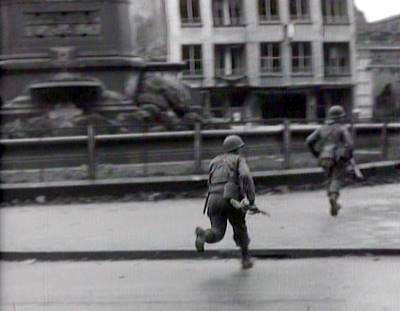
 At the fountain, the soldiers finally cross Kaiser-Wilhelm-Ring. At the fountain, the soldiers finally cross Kaiser-Wilhelm-Ring.
Only about an hour after the shelling of the car shown in the film, the US troops have advanced along Kaiser-Wilhelm-Ring to Christophstrasse and finally reach the car still standing on the right side of the road. The woman is lying next to the car and is now being examined by an army medic 
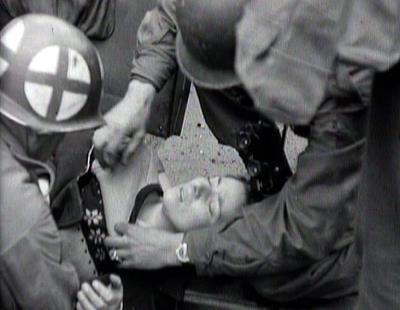
 The woman as she lies on the ground next to the car. The woman as she lies on the ground next to the car.
On the film images, various hits on the rear of the
car can be seen. 
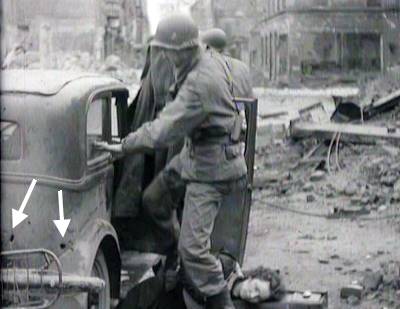
 Marked with arrows the bullet holes. Marked with arrows the bullet holes.
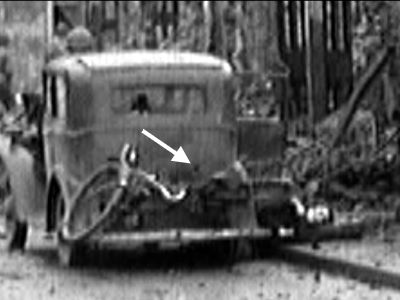
 And here marked with arrow the bullet hole caused by the hit shown further above. And here marked with arrow the bullet hole caused by the hit shown further above.
A photograph of the driver's side of the car shows the dead driver of the car 
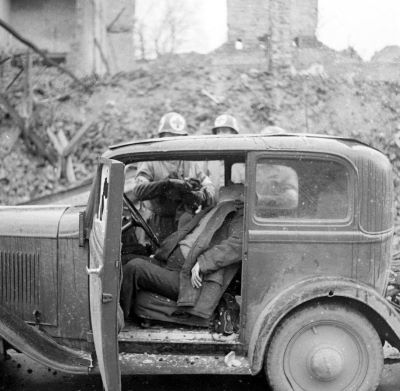
source: John Florea - LIFE Photo Collection
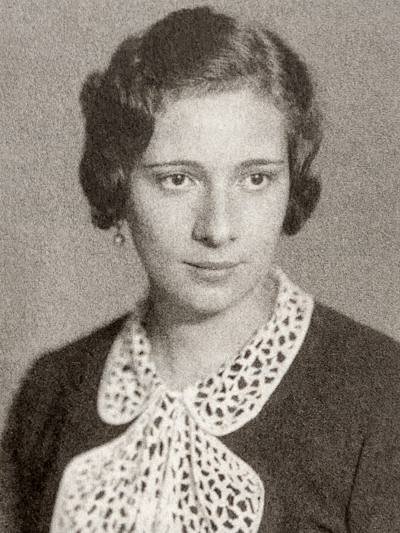
source Adam Makos |
|  After some research and a corresponding call for help in a Cologne daily newspaper, the Cologne journalist Hermann Rheindorf found out that this young woman was the 26 year old Katharina Esser from Cologne and presents some more background information about her and her fate on his DVD "Köln 1945 Nahaufnahmen". However, we will not go into this further background information here. After some research and a corresponding call for help in a Cologne daily newspaper, the Cologne journalist Hermann Rheindorf found out that this young woman was the 26 year old Katharina Esser from Cologne and presents some more background information about her and her fate on his DVD "Köln 1945 Nahaufnahmen". However, we will not go into this further background information here. |
On the DVD it is also shown in the following that the young woman in the further course of the events after the apparent calming of the situation in the context of a sudden nevertheless again flaring up combat situation (attack on the US troops with a bazooka out of a house) was accidentally rolled over and killed by an US tank. Whether this actually happened will be a topic on this page later.
But instead of being satisfied with this cruel realization, which is already seen on its own, Rheindorf goes a bit further in his documentary. On the DVD a film clip is shown, which shows a mangled corpse lying on Christophstrasse, here a still of this scene 
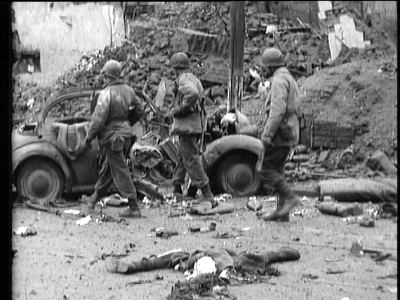
The question
It becomes almost touching when Rheindorf asks the audience whether the mutilated corpse that can be seen there is Katharina Esser, whereby he also confidentially calls Katharina Esser "Kathi" Esser ("Kathi" is a chummy shortening of "Katharina"):
"The thought that one of these corpses could be Kathi Esser does not only leave me with a queasy feeling"
Commentary from the DVD "Köln 1945 Nahaufnahmen" (Cologne 1945 close-ups)
Is it really necessary that in a film documentary one must now absolutely assign torn up body parts to a certain person ? Who should benefit from this ? Should the surviving relatives be able to look at a "very last photo" of "Kathi" ?
Then he asks an expert, a former head of a criminal investigation department (who had already been asked by Rheindorf about the cable theory (but had come to a wrong result there), whether this corpse is the young woman Katharina.
In view of the soldier's clothing of the corpse parts still striking despite tearing the expert comes however already after short examination to the - also in my opinion correct - result that it cannot be the young woman whose body is to be seen there torn on the street lying.
If one looks at the relevant entire section of the DVD on the subject Katharina Esser once completely exactly, the question forces itself already early whether this concrete question Rheindorfs "Is this corpse Katharina Esser ?" and the accomplished analysis of the former criminal policeman was also only in the remotest at all necessary or meaningful.
The car
First of all, the vehicle in the background of the still picture from the film shot at that time is not the car where Katharina Esser was sitting in. Her car is on the opposite side of Christophstrasse and a little further back in the direction of Kaiser-Wilhelm-Ring / Gladbacher Strasse. Esser's car is - as you can see on the film pictures - undamaged except for the smaller bullet hits. This car here is almost completely destroyed.
At this time, there are a total of 3 cars or wrecked cars (white arrows) in this section of the street.

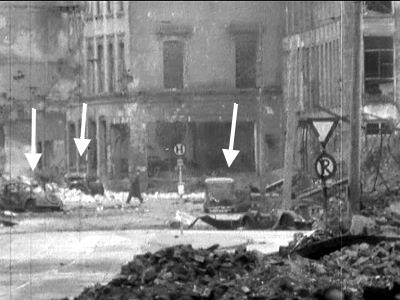
 This street area seen again from the direction of Gladbacher Strasse into town, when the US troops had not yet fought their way there. The car on the far left is the one in front of which the body parts are lying in the photo above. Also at this time already more a wreck than a car. Further behind it another vehicle can be seen, this is the one on which the man standing next to it in the film shot was standing at the passenger door and the driver was lying dead on the driver's seat. The car of Katharina Esser is already on the right side of the street. Here to see also the further above already described person who recklessly crosses the street on foot and is shot at. This street area seen again from the direction of Gladbacher Strasse into town, when the US troops had not yet fought their way there. The car on the far left is the one in front of which the body parts are lying in the photo above. Also at this time already more a wreck than a car. Further behind it another vehicle can be seen, this is the one on which the man standing next to it in the film shot was standing at the passenger door and the driver was lying dead on the driver's seat. The car of Katharina Esser is already on the right side of the street. Here to see also the further above already described person who recklessly crosses the street on foot and is shot at.
Gustav Schäfer, the crew member of the German Panzer IV, which was there at that time, later reports that at that time cars were constantly passing by in this area when he was standing there.
For these three cars now standing there, their journey did not end well.
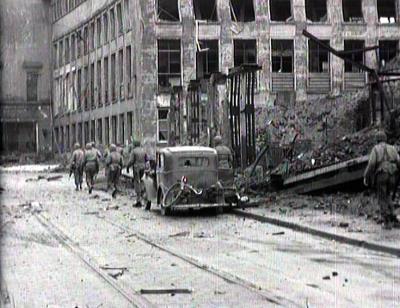
 The car of Katharina Esser, she is lying here on the ground to the right of the car. The cameraman has the Kaiser-Wilhelm-Ring in his back and stands filming in the direction of the city center / church St. Gereon. A short distance further into the city, behind the crossing Von-Werth-Strasse, there is another car, it is the car described above, next to which the man was standing in the film clip and in which the dead driver is lying. If you have seen the close-up of the car above, you can also see here the two legs of the dead man sticking out of the car. The car of Katharina Esser, she is lying here on the ground to the right of the car. The cameraman has the Kaiser-Wilhelm-Ring in his back and stands filming in the direction of the city center / church St. Gereon. A short distance further into the city, behind the crossing Von-Werth-Strasse, there is another car, it is the car described above, next to which the man was standing in the film clip and in which the dead driver is lying. If you have seen the close-up of the car above, you can also see here the two legs of the dead man sticking out of the car. 
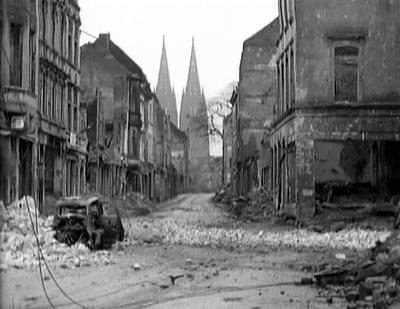
 The corresponding film shot was taken approximately from the position where the car of Katharina Esser was standing. Visible also debris on the street, which had fallen on the street after the shelling of the house fronts there by the Pershing. The corresponding film shot was taken approximately from the position where the car of Katharina Esser was standing. Visible also debris on the street, which had fallen on the street after the shelling of the house fronts there by the Pershing.
If one goes a little further in the direction of the cathedral already visible in the background and turns around, one has the following view back in the direction of Gladbacher Strasse / Kaiser-Wilhelm-Ring 
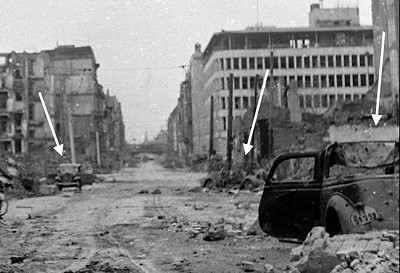
source: John Florea - LIFE Photo Collection
 On the right you can see the car from the previous picture in the foreground and behind it the destroyed car with the (here, however, hardly visible) body parts in front of it. On the left side of the street the car of Katharina Esser (all cars marked with arrows). On the right you can see the car from the previous picture in the foreground and behind it the destroyed car with the (here, however, hardly visible) body parts in front of it. On the left side of the street the car of Katharina Esser (all cars marked with arrows).
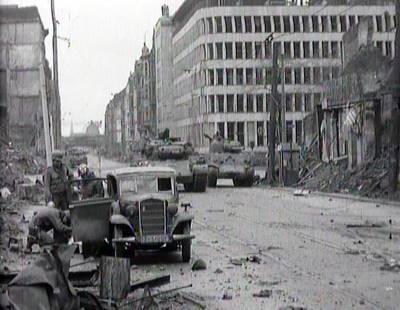
 Closer view from the front of the Esser's car. Closer view from the front of the Esser's car.
Here on this picture the Pershing is still in the background.
Very nice to see on this picture, by the way, that Esser's car was a civilian vehicle. The license plate is not a military one but a private one:

 The first two digits "1Z" stand for "Rheinprovinz" (rhine area). This is followed by a red angle, which means that the car was allowed to drive at all at that time when fuel was scarce. The first two digits "1Z" stand for "Rheinprovinz" (rhine area). This is followed by a red angle, which means that the car was allowed to drive at all at that time when fuel was scarce.
This special permission for a civilian car was not a good thing on this particular day, because the Americans largely assumed that only vehicles used for military purposes would be on the road. And so that the military enemy... and so a target ...
Below is an aerial view of this area, but taken at a completely different time, there is no debris in the streets 
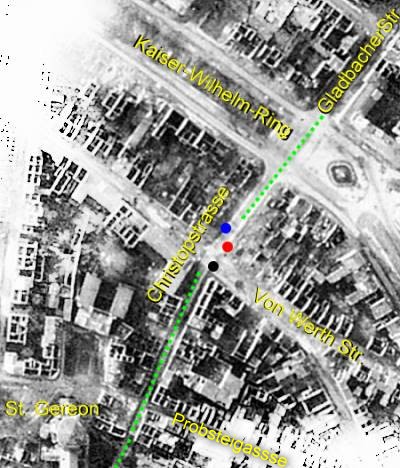
 The positions of the three cars in Christophstrasse on March 6, 1945 are marked: blue dot - the car of Katharina Esser, red dot the destroyed car with the body parts in front of it, black dot the third car with the dead driver, already positioned a bit further in the direction of St. Gereon church. The positions of the three cars in Christophstrasse on March 6, 1945 are marked: blue dot - the car of Katharina Esser, red dot the destroyed car with the body parts in front of it, black dot the third car with the dead driver, already positioned a bit further in the direction of St. Gereon church.
I took the trouble to create a panoramic panning shot of the junction from several available images as part of a photomontage:
 Photo sources used: Walter Dick Archive, NARA and John Florea - LIFE Photo Collection. Photo sources used: Walter Dick Archive, NARA and John Florea - LIFE Photo Collection.
|
|
 Sound for panoramic panning Sound for panoramic panning |
This is the time when the US troops arrive in the area of the car. The pan goes from the west (from the direction of Gladbacher Strasse) across the northern junction of Von-Werth-Strasse towards the east (in the direction of Gereonstrasse / St. Gereon.
Three destroyed cars are standing in the intersection area, Katharina Esser is being treated next to the car, Smoyer's Pershing and another tank reach the road area from the west.
If animation does not work on the browser, here direct link.
In addition the same picture with explications.
Again back to the body parts. The still image from the film already shown above, which is used as the basis for the analysis, may actually already show the correct assignment of the body parts to the correct car.


 The car looks like it was destroyed by an explosion and the body parts could have come from a person who was thrown out of the car through the door and torn apart in the explosion. The car looks like it was destroyed by an explosion and the body parts could have come from a person who was thrown out of the car through the door and torn apart in the explosion.
A total of two badly mangled body parts can be seen in the photos and footage of this area of the street. The body from the film footage (still image above), moreover you can see another body part in a photo also taken there at that time 
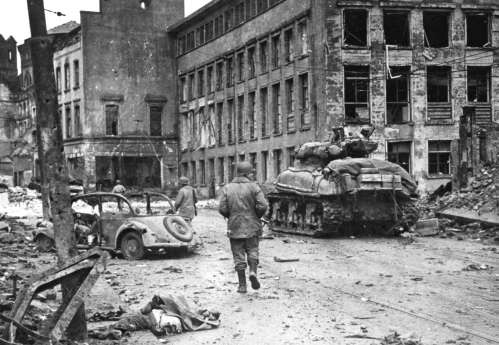
 Here in the foreground on the left side of the road is another mangled body part. It has a certain similarity with the body part seen on the other picture. So is it the same body part, which has only been pulled away from the middle of the road to the roadside in the meantime ? Here in the foreground on the left side of the road is another mangled body part. It has a certain similarity with the body part seen on the other picture. So is it the same body part, which has only been pulled away from the middle of the road to the roadside in the meantime ?
In the background one sees on this photo behind the soldier walking directly in front on the road just still something on the road lying. This could be from the position on the street and in relation to the car on the still picture quite also the other body part from the still picture from the film, here in particular the boot 
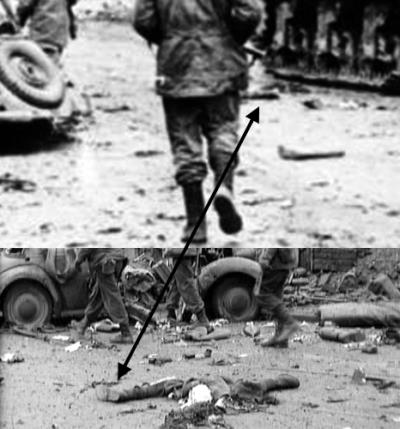
Also on the still from the movie something can be seen in the background, which could well be the other torn body part (left arrow) 
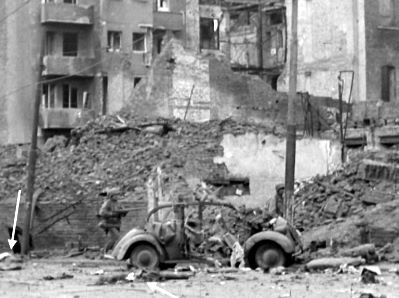
 So the probability is very high that these are two different body parts. Possibly these two body parts also belong to the same killed person ? However, on the film pictures at the car also at least another boot is to be seen lying on the street ... So the probability is very high that these are two different body parts. Possibly these two body parts also belong to the same killed person ? However, on the film pictures at the car also at least another boot is to be seen lying on the street ... 

 ... (directly to the right of the feet of the right of the three soldiers to be seen), so that some speaks for the fact that it will rather be about remains of at least two persons who have sat in the exploded car. ... (directly to the right of the feet of the right of the three soldiers to be seen), so that some speaks for the fact that it will rather be about remains of at least two persons who have sat in the exploded car.
The cameraman
Rheindorf himself then gives an excellent opportunity to prove the absurdity of his own question.
The pictures with the mangled body parts are obviously shot by a film cameraman (i.e. Bates or Rosenmann) at the scene of the event, while Katharina Esser is still lying next to her car and is being treated.
According to the explicit presentation on the Rheindorf DVD, the allegedly suddenly resurgent fighting, in the course of which Katharina Esser is run over and killed, occurs only after the cameramen have long since left the scene. When showing the film images from Christophstrasse, Rheindorf comments as follows:
"What happened ... after these presumably last shots ? The cameramen continued to advance towards the cathedral, always close to Clarence Smoyer's Pershing tank"
Comment from DVD "Köln 1945 Nahaufnahmen" (Cologne 1945 Close-ups)
But if the cameramen were already away to the cathedral when the fighting flared up again, how should these cameramen have been able to take the shots of a Katharina Esser who had already been run over???
The location
And independent of the previously described impossibility that it was Katharina Esser's body parts. Katharina Esser lay - as one can see very well in the film - on the side of her car facing away from the road, thus quasi on the sidewalk.
If a tank rolled over her there, how should she have come to the other side of the street as a run over mangled corpse ?
Body parts there much earlier ?
On the film pictures, which were still made with telephoto lens from Gladbacher Strasse, before the US troops crossed Kaiser-Wilhelm-Ring and came to Christophstrasse, I look for further clues to the body parts filmed in Christophstrasse. Two film clips stand out.
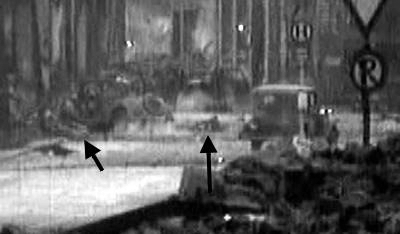
 Here on this still from the film, Katharina Esser's car is just entering the street area, being shot at. On the street around the destroyed car on the left side of the street something can be seen, which could well be injured or dead persons or parts of persons, thus in view of the situation also these body parts to be seen later in the film could be (arrows), the object arrow on the right seems thereby however here still quite large. Here on this still from the film, Katharina Esser's car is just entering the street area, being shot at. On the street around the destroyed car on the left side of the street something can be seen, which could well be injured or dead persons or parts of persons, thus in view of the situation also these body parts to be seen later in the film could be (arrows), the object arrow on the right seems thereby however here still quite large.
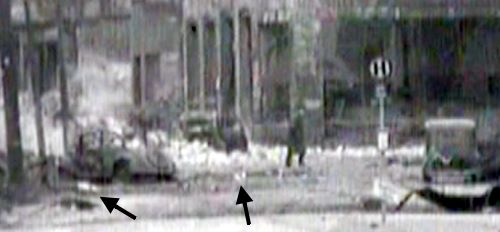
 And here another still of the shots, where the person runs over the street (and is also shot at by the US troops). And here another still of the shots, where the person runs over the street (and is also shot at by the US troops).
This scene was taken after the one from above. The car of Katharina Esser is now already on the right side of the road. Again, these two objects can be seen (arrows). The object on the right, however, doesn't seem so big anymore, it could be the same size as the part of the corpse in front of the car, which is filmed in more detail later.
The apparently reduced size of the object could be due to the fact that it was hit during the ongoing shelling of this street by the US troops and was further shredded / reduced in size. In the close-up footage, you can see some impacts of munitions on the road surface.
Quintessence
One will not be able to say it one hundred percent anymore, but the probability seems quite high that these objects lying on the road, which can be seen in the telephoto close-ups, are already the body parts of one or more soldiers, which had been thrown out and shredded by the explosion of the car standing on the left side of the road. And this already at a time when the car of Katharina Esser had not arrived there yet.
In this case, the body parts shown could not be Katharina Esser for this reason alone.
But even if one could not identify the objects on the street, which were still visible in the film pictures taken from Gladbacher Strasse, as body parts, these body parts were already there, when the film cameramen were still at the place of the event, filmed it and at the same time Katharina Esser was visibly still alive.
Since, according to Rheindorf's own account, the cameramen had already left when the fighting unexpectedly flared up again, the film images cannot show a shredded corpse of Katharina Esser.
Questioning and analysis on the DVD on the subject of whether the body parts came from Katharina Esser were really completely superfluous after all.
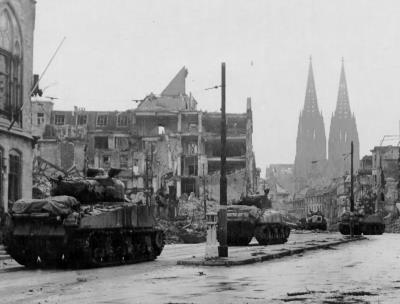
 After the troops have passed Christophstrasse, they continue in the direction of the cathedral. Here a view over the Gereonstrasse following the Christophstrasse. After the troops have passed Christophstrasse, they continue in the direction of the cathedral. Here a view over the Gereonstrasse following the Christophstrasse.
Here especially the Pershing will still play an important role in the famous tank duel at the cathedral.
Update 2014
Hermann Rheindorf follows up. In November 2014 a book about the events on March 6, 1945 and a new DVD, the so-called "Köln 1945 Nahaufnahmen - Edition 2015", i.e. a new edition of the old DVD from 2008 and another documentary called "Die tatsächlichen Bilder des Panzerduells am Dom" (the real pictures of the tank duel at the cathedral) will be released. In both documentaries Rheindorf introduces new information and statements and also drops old information and statements that were not tenable. In many cases, he also introduces additional arguments that are intended to further substantiate already existing views.
The chapter on Katharina Esser is still included in the 2015 edition, but Rheindorf has removed the sequences I criticized above with the question of whether the visible body parts could have come from Katharina Esser.
And how did Katharina Esser really die ?
According to Rheindorf's theory in the book and film, the US troops were suddenly shot at from a house by hidden German soldiers with a bazooka at this point, when the situation actually seemed to have been cleared up, the first tanks had passed through, the cameramen had already left and Esser was still waiting for further treatment. In the general panic of the soldiers, she had then been run over by an US tank.
Here, one must first understand why this depiction of later re-emerging battles occurs.
On the film pictures of the American cameramen we only see that first the car is shot at and later the American troops pass the car, with tanks and with infantrymen. At this time, Katharina Esser is lying badly injured on the passenger side of the car. Then the cameramen move on with the tanks and infantrymen along Gereonstrasse towards the cathedral, everything well documented on film. What happens to Katharina Esser then is not shown in the film.
Now there is an affidavit of an alleged witness from the year 1946, in which it is written wordlessly that the woman from the car, Katharina Esser, had been run over by a tank.
This does not fit to the film pictures, but these few words of the witness are the basis of all further theses of Rheindorf.
Because it is clear, the American units moved on towards the cathedral and Esser was to be seen alive on the last film pictures.
So how does it fit together that according to the affidavit she should have been run over by a tank ?
And since we last saw them alive in the film, this very theory is put into the world that there must have been new fights and in the course of which a panicked tank crew is said to have rolled over Esser ...
Because that must have happened after the opinion of Rheindorf in such a way, if Esser should have been run over again by a tank after the film recordings, on which she nevertheless still alive in an obviously already pacified seeming situation, in which the US troops had already moved past. How should it work then differently ?
And so Rheindorf is desperately looking for information that could support the thesis that Katharina Esser was indeed run over by a tank in the end. It is a foregone conclusion that she has been run over, now all that remains is to gather some evidence.
Well, right away, there is no valid definitive proof of this sequence of events. There is no report, which represents this expiry in such a way. As in other parts of his DVD and book documentary, in particular the last tank duel at the cathedral or the battles at the Roman tower, which I have discussed in detail on other pages of my website, Rheindorf again considers single events or documents and then constructs a certain sequence by skillful joining of information and disregard of facts speaking against it, which apparently simply leads to the solution desired by him.
However, since I know how Rheindorf deals with facts and sometimes does not handle them quite correctly, I will take a closer look at the circumstantial evidence he presents in the following. Rheindorf addresses the issue both in his film documentary and in his book.
Affidavit of an alleged witness
The most important piece of evidence for Rheindorf is an affidavit by a witness taken before the police 10 months after the events in January 1946, which is shown in the book and the film. In it, she writes in bad German language ... :
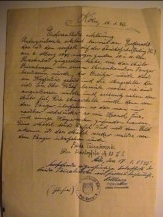
source: Rheindorf, 1945 Kriegsende in Köln |
|  "… personally watched the incident on Christophstr. (Gerling K.) on March 6, 1945 morning between 10 u. 11 o'clock, how the car private car was shot at by an American tank, the owner was killed by a head shot and the employee, who was trying to look after her boss, whereby she was also shot at and fell down sideways next to the car. The employee was then run over by the tank so that afterwards only remains as well as hand, foot and some body remains were to be found. This girl was wearing boots, and from the picture I recognise her as the girl who was run over by the tank." "… personally watched the incident on Christophstr. (Gerling K.) on March 6, 1945 morning between 10 u. 11 o'clock, how the car private car was shot at by an American tank, the owner was killed by a head shot and the employee, who was trying to look after her boss, whereby she was also shot at and fell down sideways next to the car. The employee was then run over by the tank so that afterwards only remains as well as hand, foot and some body remains were to be found. This girl was wearing boots, and from the picture I recognise her as the girl who was run over by the tank."
|
The description does not seem very convincing to me as a whole. Esser was run over afterwards by "the tank", which had already fired at the car before ?
Here easily 1 - 2 hours time are skipped, which are between 10 and 11 o'clock (firing at the car) and at least some time after 12 o'clock (filming Esser next to car) , where Esser was still alive. The witness also did not speak of a sudden tumult due to a later German shelling.
It is also questionable from where the witness wants to have seen all this. Was she standing comfortably on the side of the road or looking out of a window when the shooting between US troops and German tank took place ? There also adjacent houses were fired at and hit. The German tank was engaged in a battle with Smoyer's tank when Esser's car drove into the area. There the witness was not in cover or in a house cellar but observed in the midst of the firefight everything, also the drive of Esser's car ? And already according to the own statement of the shooter Gustav Schäfer, he had shot on the German side also in the direction of the US troops and probably also hit the car of the Essers during the approach. The witness does not say anything about this either.
In the affidavit she stated that she lived at Christophstrasse 22, a little further behind the place of the incident in the direction of the St. Gereon church. On March 6, 1945, the German tank would have stood quasi directly in front of her house and fired in the direction of the US troops when the Esser's car had turned into Christophstrasse and was fired at from both sides. In this respect it is quite strange that the witness only writes that the car was fired at by an US tank.
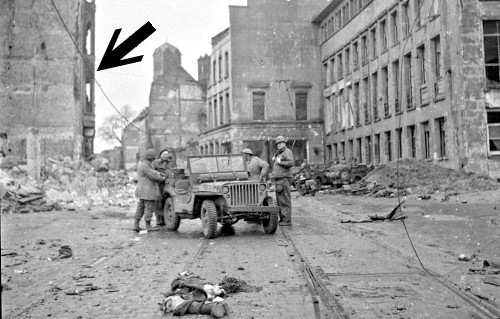
 source: John Florea - LIFE Photo Collection source: John Florea - LIFE Photo Collection
View from the area on Christophstrasse where the shot down cars are standing, in the foreground remains of the German soldier that we had already seen above. The house Christophstrasse 22, where the witness lived, was behind these houses on the left side of the street (arrow). At least from a window of the house the witness could not have seen properly into the street area at that time.
It seems even more unrealistic that the witness could have observed anything if you look at the interview given by Katharina's sister Anna Lettau in an interview by Hermann Rheindorf in 2007. In the passage of the interview, which does not appear in the film or the book and will only be published in full on YouTube by Rheindorf in 2025, she repeatedly mentions that the witness allegedly observed everything from the basement window (!). So, the witness's house behind the bend in the road and also rubble and debris on the ground in front of all the houses and then observed from the cellar window?
This photo shows the house at Christophstrasse 22, with the junction of Probsteigasse, where the German tank had retreated after being shot at, marked with a frame behind it. At the bottom of the narrow house 22 and the stores next door, there were no cellar windows at all!

 Bildquelle: John Florea - LIFE Photo Collection and NARA Bildquelle: John Florea - LIFE Photo Collection and NARA
Marked in the Recon photo of 1945 house Christophstrasse 22, position of Esser's car in Christophstrasse, yellow arrow would be the possible viewing angle from house 22. The Esser car can hardly be seen from there:

 Recon photo Recon photo
How did the witness come to the conclusion that she had seen this from the basement window? Well, she was probably really in the basement of the house at the time, like most people in Cologne in the combat zones on March 6, 1945.
The Americans fired into the houses as they advanced. Who wanted to sit quietly in their apartment?
But in a cellar, she couldn't really see anything of what was happening on the street. She was probably also asked where she had seen it all from. And she probably simply added that she could see it from the basement window. Which, as seen above, was not possible due to the lack of a basement window in this house. But obviously nobody questioned that at the time.
It is therefore already now questionable whether she actually saw something " live " at the time or whether she only described something later that she assumed from the circumstances or only inferred afterwards.
Also on film recordings during the supply of Esser by US soldiers no civilians are to be seen.
The witness also makes it sound as if Esser was run over next to the car. But next to the car, on the side where Esser lay, there were already directly rubble plots. How should at all on this narrow piece of sidewalk a tank can drive past ?

 Hardly place at the side of the car, how should find there a tank place and why ? The tank would drive on rubble / debris, thus also become worse maneuverable and moreover even in the case of a sudden fire also not in very much better cover, because the houses there were destroyed ... Hardly place at the side of the car, how should find there a tank place and why ? The tank would drive on rubble / debris, thus also become worse maneuverable and moreover even in the case of a sudden fire also not in very much better cover, because the houses there were destroyed ...
Also one sees on a photo, which must have been made obviously very many later after passage of the US troops, spatially unchanged the car of the Esser still with opened doors.
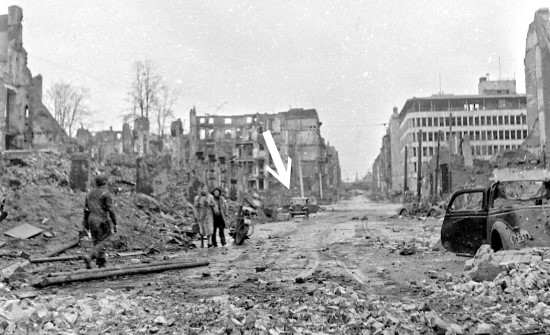
 source: John Florea - LIFE Photo Collection source: John Florea - LIFE Photo Collection
No traces of the destruction of the car (arrow) by a tank, which would have passed there on the footpath, where Esser lay, and surely would have rammed the car. Why the photo must have been taken much later ? Well, in the background, towards Gladbacher Strasse, no more tanks can be seen heading towards the city center. Therefore, the photo seems to have been taken so late that an alleged attack on the US troops at this place must have been already over - for lack of potential targets ...
You can't see a shot down tank standing there either !
And Katharina Esser is not lying next to the car anymore ! The door is open, the car (according to comparisons with pictures, when she was still lying there) still unmoved at exactly the same place. It is very unlikely that a tank would have rolled over the Esser lying next to the car in such a way that neither the door of the car would have been torn off, nor the car would have been shifted somehow, if at the same time by rolling over Katharina Esser from head to foot only body remains should have remained. A damage or a displacement of the car would have been actually completely unavoidable.
Rheindorf himself shows in the book also a photo from that time when the photo above was taken. It also shows the two ladies at this location, only 1 or 2 minutes after the picture taken above. In the background the Esser's car. Rheindorf also writes, as I do here, that this is a later picture, in which the car "appears to be seen untouched in the background." So Rheindorf also assumes that Esser would still have been lying next to the car when she was run over and the car would also have been damaged by this. According to Rheindorf, Esser must have been lying next to the car at this moment of the photo, because it was apparently undamaged. And in the book he also explains in the following of the photo, why it should have come quasi afterwards to this photo still to the sudden renewed fight situation. Actually he has contradicted himself with it, because ...
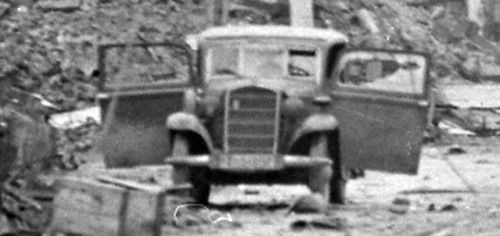
 source: John Florea - LIFE Photo Collection source: John Florea - LIFE Photo Collection
The car again at the same later time, only in an enlargement of another picture from these same minutes (the photographer John Florea had taken several photos in the street in these minutes). Esser, as I said, is no longer lying next to the car !
Of course Rheindorf did not mention this in his book about this photo ! He writes indirectly only that the car is not damaged here yet and therefore Esser could have been run over beside the car only afterwards.
The story that Esser fell out of the car and was run over by a tank next to it cannot be true.
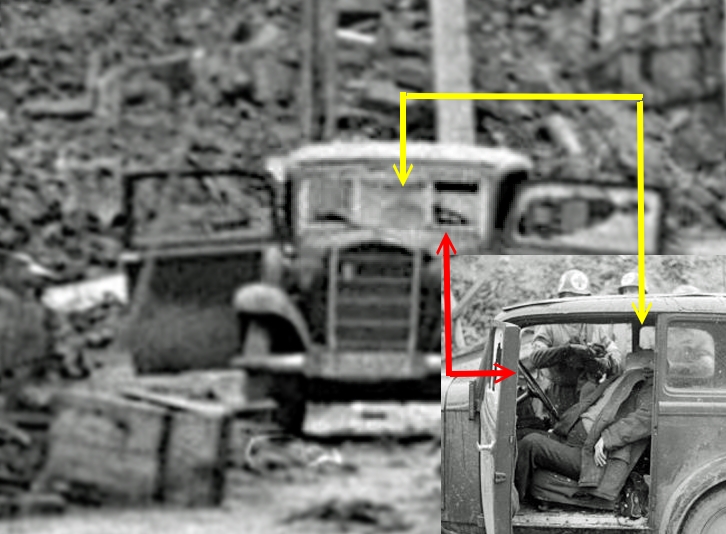
 source: John Florea - LIFE Photo Collection source: John Florea - LIFE Photo Collection
And something else stands out when you take a closer look at the picture. As noted above, Katharina Esser is no longer lying next to the car here. But the driver, her boss Delling ...
... is still sitting dead on the driver's seat !
He is sitting slightly tilted to the side towards the passenger seat. The comparison with the other picture from above shows it clearly. Delling and the steering wheel are clearly visible through the windshield.
Katharina Esser was obviously taken away from the car, the dead Delling was left in the car ...
But before we come back to the affidavit in more depth later, let's first look at the other "evidence" Rheindorf presents to support the thesis that Esser was run over by a tank....
The house from which the German soldiers were shooting
It is exciting to examine the different statements of Rheindorf, that he can't quite agree from where the German Panzerfaust attacker should have fired. In the book on page 134 there is talk about a "house directly at the Gereonstrasse", in the film from a house "directly at the Christophstrasse", so one time Gereon-Street, then also Christoph-Street ... 2 different streets ...
Nothing is shown, no photo, no report or other text is shown, where one can see / read this street name clearly and explicitly letter by letter. Text passages are shown, but they do not contain the street name. The street names are simply claimed, like it or lump it ... hmmm... not very trustworthy ...
The allegedly shot down Sherman
Rheindorf shows in his book, first edition, as further alleged proof also the picture from further above, on which a tank stands at the crossing behind Esser's car:

 Rheindorf writes about it: "The picture possibly shows the situation after the attack on the US troops with a bazooka. The Sherman tank standing on the right is said to be a downed combat vehicle." Rheindorf writes about it: "The picture possibly shows the situation after the attack on the US troops with a bazooka. The Sherman tank standing on the right is said to be a downed combat vehicle."
"Is said to" ... aha, very exciting. Who specifically says that it is said to be a shot-down combat vehicle? Source ?
Well, the picture from the German archives "Bundesarchiv", listed under picture 146-1971-053-63, is there in the archives named "Sherman in front of destroyed building".
In the historical U.S. original description it says "Infantrymen and armor of the First U.S. Army proceed through the streets of war-battered Cologne. A body lies in the guttor at left.".
They proceed ! So no indication in the official sources that this is a downed tank ! By the way, the tank is a so-called Sherman M4A1 DD, a variant of the Sherman tank that can also be used as a floating tank.
Why Rheindorf says it is a shot down combat vehicle is neither explained by the photo description nor by any other evidence shown in book or film, so maybe it is just wishful thinking for his theory ...
But I also search again for other pictures from this area to back up and find a photo of the US Signal Corps, which after years of research around the events of March 6, 1945 is certainly known Rheindorf and shows a row of US tanks on the advance later following Gereonstrasse:
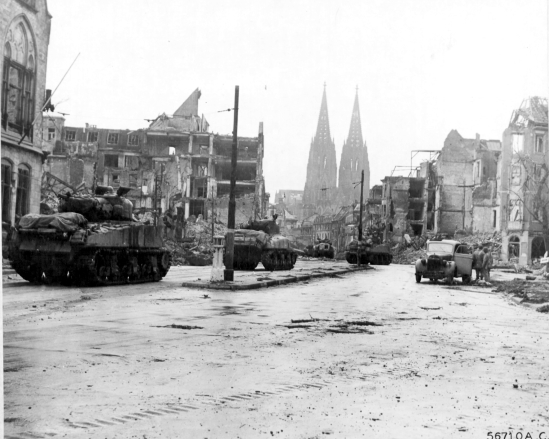
 And lo and behold, the tank, which according to Rheindorf should have been shot down before, drives there as the second from the left cheerfully in the column in the direction of the cathedral, the area at the Christophstrasse had already passed the tanks. In his book hundreds of pictures of Cologne on this day are shown and Rheindorf prides itself on having the most extensive collection of photos in the book... Of all things, this picture from Gereonstrasse, which shows the allegedly shot down Sherman and thus would disprove his proof, is not included ... hmmm ... And lo and behold, the tank, which according to Rheindorf should have been shot down before, drives there as the second from the left cheerfully in the column in the direction of the cathedral, the area at the Christophstrasse had already passed the tanks. In his book hundreds of pictures of Cologne on this day are shown and Rheindorf prides itself on having the most extensive collection of photos in the book... Of all things, this picture from Gereonstrasse, which shows the allegedly shot down Sherman and thus would disprove his proof, is not included ... hmmm ...

 The comparison of the two pictures is clear, it is a M4A1 DD, the arrangement of the boxes with ammunition on the rear of the tank is like a fingerprint and each tank has a different arrangement or color variations of the boxes at this day. These are actually identical. So the armoured car drove from Christophstrasse onto Gereonstrasse as normal. The comparison of the two pictures is clear, it is a M4A1 DD, the arrangement of the boxes with ammunition on the rear of the tank is like a fingerprint and each tank has a different arrangement or color variations of the boxes at this day. These are actually identical. So the armoured car drove from Christophstrasse onto Gereonstrasse as normal.
So this tank was definitely not shot down in Christophstrasse... Addendum: in the second edition of his book the photo with the allegedly shot down Sherman and the commentary are no longer included, by the way, he must have read my website ...
The historian
Another alleged proof is also curious.
Rheindorf refers with regard to an bazooka firing of a Sherman in the film first to a "internal records" of a "little-known German military history researcher”", said to be treating a Sherman firing on Christophstrasse.
Aha, "little known", without mentioning names and exact source is strange, when Rheindorf otherwise always attaches so much importance to naming sources in films and books. But not here ... ??? So you can't research the researcher and its credibility. Quite strange ...
To this end, he fades in a short passage of text in the film, which allegedly comes from this essay by the researcher and, according to Rheindorf, is supposed to deal with a Sherman firing in Christophstrasse. However, there is no mention of Christophstrasse or Gereonstrasse in the text shown in the film.
There is also nothing in the text about a woman, and certainly not about a woman who is supposed to have been run over by a tank.
The researcher wants to know the name of the German marksman, it is said to have been Hptm Rose.
The text probably also includes a photo to which the text refers. According to the researcher's description, it allegedly shows the "window cavity of this building", from which the Panzerfaust is said to have been fired. In addition to the reference to the firing of a Sherman, which can be seen in the photo, reference is also made to a German car that can probably also be seen, which in turn is said to have been hit by American artillery. A German soldier is said to have been thrown out of the car in the explosion and horribly torn apart. The author comes to the conclusion that Germans and Americans fell within a radius of just 10 metres and that this shows the folly of war.
The question therefore arises as to what kind of photo the researcher is referring to. In any case, Rheindorf makes no mention of a photo in the commentary, nor is it presented or identified more precisely. That's a bit strange, given that Rheindorf's goal of proving a shoot-down would possibly be an additional or independent piece of evidence ?
But let's first take a closer look at the historian's text.
Directly I am surprised that the allegedly relevant text passage predominantly takes up only a small part of the picture and also can not be seen completely - very strange. What is this ?
Moreover, I notice that the text shown mentions a time when a tank is supposed to have been shot down by a bazooka.
"The "Sherman" tank was shot down on the morning of 06.03 '45, around ..."
Yes, around ... ????
Time ... ????
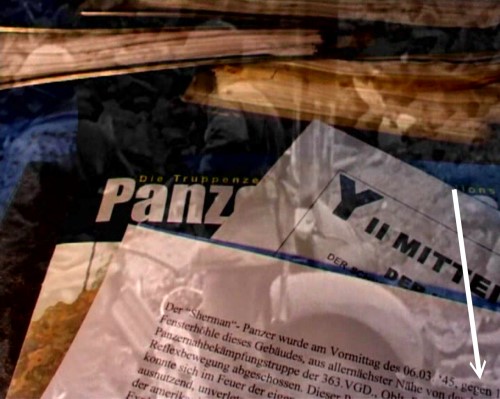
 From the film: the background takes up a lot of space compared to the decisive text. The time of the incident mentioned there, however, is almost "perfectly" cut off or not recognizable for the normal viewer of the film, the passage also slowly pans out of the picture. From the film: the background takes up a lot of space compared to the decisive text. The time of the incident mentioned there, however, is almost "perfectly" cut off or not recognizable for the normal viewer of the film, the passage also slowly pans out of the picture.
This makes me already suspicious after all my experiences with the documentation style of Rheindorf, particularly since also the word "morning" is contained in the text to the incident, thus actually a time BEFORE 12 o'clock.

 Documents, which are unrestrictedly harmless or even helpful for him or his theories (like the affidavit of the witness), he shows in the film mostly gladly well readable (screenshot from Rheindorf's film - to be seen in the book also completely). But as far as letters, books, documents are made difficult to read, especially in the film, by showing excerpts and "camera flights" over the document, where one can't really recognize or read the text in a hurry, it usually becomes adventurous with his rendering of the alleged content ... Documents, which are unrestrictedly harmless or even helpful for him or his theories (like the affidavit of the witness), he shows in the film mostly gladly well readable (screenshot from Rheindorf's film - to be seen in the book also completely). But as far as letters, books, documents are made difficult to read, especially in the film, by showing excerpts and "camera flights" over the document, where one can't really recognize or read the text in a hurry, it usually becomes adventurous with his rendering of the alleged content ...
So what did he possibly want to disguise by this strange presentation of the text ?
I look at frame by frame of the film sequence and shall be right with my skepticism.
In the first frame of this film sequence, a small piece of the time written in the document can actually be recognized during the insertion, before it disappears in the next frames very quickly from the visible area. The normal film viewer does not see this, so quickly is the area of the text in the normally running film already out of the picture again. But the enlargement shows it:
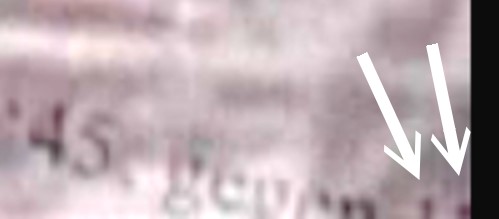
 Not easily recognizable, but the first number of the time is in any case a "1" and the second number, as it looks, must also be a "1". In any case, it is not a "2" ! Not easily recognizable, but the first number of the time is in any case a "1" and the second number, as it looks, must also be a "1". In any case, it is not a "2" !
With that, the time mentioned was not to be seen:
11 o'clock
So the normal movie viewer could not see this time. And it is not mentioned in the commentary of the film, of course.
Let us remember the soldier's watch in the film scene in which Katharina Esser is treated. Rheindorf himself had zoomed in on it in the documentary and found that it showed a few minutes after 12 noon, when Esser was being treated.
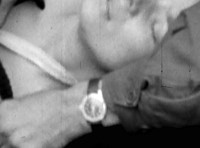
 "A few minutes after 12 o'clock" Rheindorf records in the commentary of this film scene ... "A few minutes after 12 o'clock" Rheindorf records in the commentary of this film scene ...
Thus the firing of a Sherman, to which Rheindorf refers here, was in reality 1 hour before the scenes showing the treatment of Esser on the ground next to the car ! The shooting described there could not have caused a panic situation in the Christophstrasse, in which Esser would have been rolled over and at 11 o'clock there were no US tanks in the Christophstrasse at all, because the US troops were still in the Gladbacher Strasse on the other side of the Kaiser-Wilhelm-Ring at that time. So the firing of this Sherman must have happened somewhere else entirely. In every case not in Christophstrasse.
Excitingly, this "piece of evidence" is also only shown in the film, where the defensive pointing technique can be used to hide the time. In the book this report of the historian is not mentioned at all. Of course, one would have to show a picture of the report and then one would be able to see the time or one would have to show only a small section of the report without the time and that would have been very conspicuous ... So you cover the time in the movie and you don't have to mention it in the book... A time that would not fit at all to what he wants to prove ...
And 11 o'clock is confirmed by another film clip. Rheindorf states that, elated by the above findings, he wrote to a newsletter of the US 3AD (which is also read by veterans), in order to perhaps be able to learn more details of a shooting down of a US tank there from the veterans who were in Cologne at the time. The letter he wrote is shown in the film, but reading it is made difficult by a camera flying over the paper in different directions. But again, a freeze frame then makes it clear after all...
So what does Rheindorf write to the US Army veterans at the time of the tank firing ?
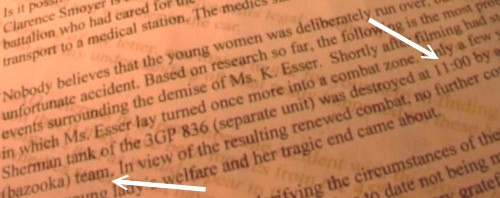
 He himself refers in his letter already directly to a firing expressly at 11 o'clock (right arrow) ! Not at 12 o'clock or later, when Esser still lay alive beside her car ! A firing at 11 o'clock could not have led to any analyzable result with regard to the allegedly after the film scene with Esser at 12 o'clock again flared up fight with firing of a tank and from it resulting overrunning of Esser, which theoretically should have taken place around 12.30 pm at the earliest?? He himself refers in his letter already directly to a firing expressly at 11 o'clock (right arrow) ! Not at 12 o'clock or later, when Esser still lay alive beside her car ! A firing at 11 o'clock could not have led to any analyzable result with regard to the allegedly after the film scene with Esser at 12 o'clock again flared up fight with firing of a tank and from it resulting overrunning of Esser, which theoretically should have taken place around 12.30 pm at the earliest??
The "little known" researcher's small text excerpt also contains another interesting piece of information.
It can be read that the anti-tank gunner is said to have fired in a reflex movement!

 Hmmm, "Reflexbewegung" = reflex movement ... Hmmm, "Reflexbewegung" = reflex movement ...
A reflex movement is when someone is surprised by something in a situation and then develops an activity as a reflex, i.e. without having planned it exactly or thought about it ...
So the shooter fired in a reflex movement, i.e. unplanned and without thinking?
But that doesn't fit with Rheindorf's thesis that US troops moving up were deliberately attacked. So if someone sneaks into a house or hides there in order to deliberately trap and attack someone, that's not a reflex. You wait for a suitable opportunity and are prepared...
Let's come back to the question of which photo the "little-known" researcher was probably referring to in his text. I think about it for a long time, wondering why Rheindorf doesn't specifically present this photo. "That's the house!", it's actually that simple ... Does he himself not believe in the veteran's description and perhaps wants to make it more difficult for sceptics to investigate ?
I am also pondering why Rheindorf no longer shows the photo from the above section "The supposedly shot down Sherman" with the Sherman that turned out not to have been shot down in the second edition of his book. I'm also thinking about Rheindorf's reference in the book that the Sherman shown should have been shot down, i.e. the reference to someone else who actually claims that.
Then the scales fall from my eyes. I now know which picture the "little-known" researcher had used for his illustration !
It must be this photo, which we already know from above 

 The picture from the US Archives, which was only included in the first edition of Rheindorf's book. The picture from the US Archives, which was only included in the first edition of Rheindorf's book.
"Window cave" fits the rather demolished office building of the Gerling Group in the background, many destroyed windows in a row and over several floors. An exploded German car on the left with a horribly torn German soldier in the foreground also fits, a Sherman to be seen about 10 metres away also fits in principle (only as we know not shot down) !
Yes, that must be the picture the researcher was referring to with his text ...
That is why Rheindorf states that the Sherman in the photo was "supposed" to have been shot down. The researcher's text and especially the photo are therefore the source to which Rheindorf refers.
But unfortunately the researcher has obviously made a mistake!
We definitely know that the photo shows a Sherman that was not shot down, as it was still travelling on Gereonstrasse later on.
We know that the photo does not show an event that took place at 11 o'clock, because the US troops were not yet in Christophstrasse at 11 o'clock but in the Gladbacher Strasse area. At 11 o'clock Gustav Schäfer was still standing in Christophstrasse with his tank and firing in the direction of the Americans. The photo was actually taken when the US troops had reached Christophstrasse and were already moving on towards the cathedral, i.e. around 12:15 to 12:30 at the earliest.
The description of the shot as a reflex action does not fit with an ambush, which an attack on advancing troops would have been.
And there is something else: after describing the shooter's reflexive movement when firing, the researcher's text also includes the following passage:
"This anti-tank squad was able to escape unharmed, taking advantage of the momentum of surprise and the fire from their own machine guns."
Now let's take a look at this office building, a large office building. Let's imagine that a bazooka had been fired at a tank from one of the windows. How would it be possible to retreat using machine guns? After the shot, the members of the anti-tank squad gathered in the building run into the interior of the office building firing machine guns, or how else can one imagine retreating within a large office building? What are they shooting at while running in a building?
And then they are also in an area that has already been taken over by the Americans, so there are Americans in the streets around them... where are they supposed to go? In every direction, they run into Americans...
Apart from that, how could they have even entered the building in the first place in an area already occupied by the Americans?
No, the researcher's description does not fit with a shot fired from this office building.
The description, together with the reflex movement, might perhaps fit, for example, an action in which a mobile squad on the German front line suddenly encounters an American tank and soldiers while running through the streets, the bazooka operator aims the bazooka at the tank in a "reflex movement" and fires, and the accompanying German soldiers fire at the Americans as they retreat back into cover ...
Yes, the destroyed car and a horribly torn German soldier are also there. But apart from that, the photo does not reflect what the "little-known" researcher is explaining, the shooting down of a US tank.
The "little-known" researcher named an inappropriate time, shows a Sherman that was not shot down, even describes American fatalities, but knows nothing about two other German cars that were also hit there, their two dead drivers and a seriously injured woman. Not much to suggest that the depiction is supposed to be a research result ...
How does the researcher even know that it was precisely this location in Cologne and this office building from which the shots were fired ? Even Rheindorf, despite extensive research, obviously does not succeed in finding out anything conclusive from classical sources. This "little-known" researcher wants to know better ?
Even in the historiography of the 363rd VolksGrenadier-Division, to which Hptm. Rose belonged, it is only stated, without a more precise local description, that Rose is said to have shot down one or two Shermans in Cologne. Yes, somewhere in Cologne, but where exactly is not noted there either (but this probably happened in the Nippes district, 2 - 3 km from Christophstrasse, as I will explain in more detail later).
And the "little known" researcher claims to have known the supposed location ? From what source ?
In the American documents on the advance in Cologne there is nothing about a firing there, but in other places (more northern parts of the city / at the cathedral) there is.
No, the supposed "evidence photo" simply shows a snapshot of a US Army photographer accompanying the units on the Christophstrasse with advancing US troops and "defeated" dead Germans, an interesting motif. The house of the Gerling Group is obviously only accidentally in the background.
Incidentally, the 363rd was mainly recruited from soldiers from the Stuttgart and Wiesbaden regions when it was formed in 1943. It is rather unlikely that this Hptm. Rose knew the locations in Cologne or even a specific house in Cologne from where firing took place during a combat situation, let alone was able to describe later where exactly something had happened.
So one has to ask oneself what the researcher knew or could have known at all?
Here it becomes clear why the researcher is probably "little known" - and, it must now be said, obviously rightly so ....
He took an apparently suitable photo from the Federal Archives and obviously wanted to make a story about the madness of the war, in which Rose was then involved. He was certainly aware of a shooting down by Rose somewhere in Cologne from the history of the 363rd.
Perhaps the researcher did not even know that the photo was taken in Christophstrasse. The Federal Archives and the original US Army source do not name a location or street in the details of the photo. If the "little-known" researcher, who is unfortunately unknown to us, was a stranger to the area, that would be a further explanation.
And all this also makes it clear why Rheindorf did not label the photo with the note that this was the house from which the shot was taken in the book and in the film ! It would have been so easy! Instead, Rheindorf fables in the film that a Sherman was shot from a "house directly on Christophstrasse" (in the book, a "house directly on Gereonstrasse").
He could have shown the photo with the house directly, but he didn't. Why ?
Clearly, Rheindorf himself is not convinced of the story, hence the distant reference that the Sherman in the photo was "supposed" to have been shot down! Clever ...
In order to prove that something was shot down, he is happy to show the researcher's text and make a connection to Christophstrasse. But he would rather not show the photo ...
The discrepancies in the photo and the story the researcher tells about them were certainly too great for him ...
In any case, it is clear to me that, for the reasons mentioned above, the researcher's account is based solely on the basis of a firing that took place somewhere in Cologne and the purely detached interpretation of a photo. The researcher's account of the evidence of a US tank being shot down in Christophstrasse must therefore be rejected as unsound.
The veteran
Next, he mentions a letter he received from an US veteran as a reaction to his letter. In the film, the letter can again only be seen in part and therefore difficult to read as it flies through the frame. Rheindorf comments that the soldier had been "at this spot" and had been shot down !
Sounds like another supposedly convincing proof (the viewer of the film does not know the time difference and understands by "at this spot" of course the street section of Christophstrasse, where Katharina Esser lay wounded.
So "at this spot" he was actually shot down ? So do we now have proof that the alleged renewed flare-up of hostilities took place ? In other words, the proof that Rheindorf is desperate to provide in order to prove that Katharina Esser was rolled over ?
In the book, Rheindorf varies "at this spot." He writes that the veteran was shot down "in this area". The letter is also fully visible in a very small photo. The veteran describes in it indeed that his tank had been shot down by a Panzerfaust at noon on 6.3.1945. Following the text passages from the letter, which refer to localities in Cologne.
| "I know nothing of her (Katharina Esser) situation at that time. I am writing because I was a tank crewman in the city on that day.
I was a member of Company D ... and our tank was "knocked out" by a Panzerfaust about noon of that day. We had approached the city from Pulheim and through the airfield and went in among the city buildings.
A German soldier fired a Panzerfaust at us from the second floor of what I remember was an apartment house. The shell hit ... "
|
Where he was shot down, the veteran does not write at all !
.
He writes in summary only that he was in the city of Cologne on the road and had been shot down from a building with a bazooka. No reference to a specific location, a district, a street ... .
In the book Rheindorf goes one step further than in the film. There he writes under the photo of the veteran shown there:
| "... he is shot down and injured in the Gereonsviertel with his tank crew. ..."
|
Wow ! The veteran did not write that at all in his letter that he was in the area "Gereonsviertel" - in Englisch "Gereon's Quarter" - , this is how the region in this area of Cologne is called, referring to the church St. Gereon located there. But Rheindorf just pretends that the veteran said that and presents it as a fixed fact ! The Christophstrasse, where the incident with Katharina Esser happened, is located in the "Gereonsviertel" - .
So Rheindorf cleverly suggests to the reader that the tank was shot down "there" and thus the story with the tank rolling over must be true because of a renewed combat situation !
Rheindorf only succinctly (but still) points out in the film that this soldier was traveling with D Company, which was "one house block" to the north from Smoyer's unit...
Hmmm, "one house block" away ... ???
So not traveling with Smoyer's unit on Christophstrasse...
So did this soldier and his tank even pass Christophstrasse ? And why should the unit go there at all, if it was already heading further north towards the city center before ?
And what is "one house block" distance in Cologne ?
My scepticism is also supported by a map from the book ‘Spearhead in the West’, which Rheindorf shows in the film, while at the same time he comments that he had received a letter from the soldier and that the soldier with his unit had been only one block away. In the book, this map is printed in faint gray as the background of the entire page with Rheindorf's corresponding comments, you can't see much on the map because of the overlapping text and photos on the page.
This map, which contains English designations as well as handwritten annotation " ...into the city" was thus presumably copied by this soldier from the book and attached to his letter. The map contains a continuous colored marking of various streets, which starts from city of Pulheim along the airport Butzweiler Hof via city district Longerich towards the city center (the soldier also writes in his letter that he drove via the airfield).
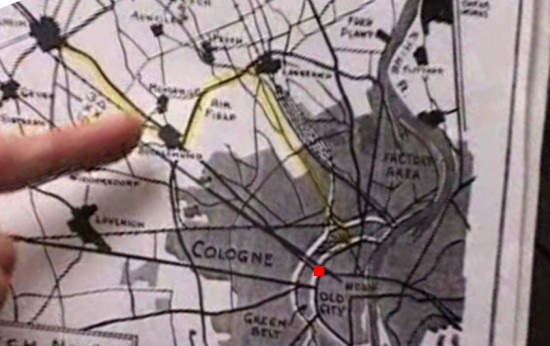
 The map obviously marks the route that D Company, in which the soldier was, had taken into the city. D Company was part of the so-called task force Kane, which consisted of the medium tank companies of the 1st battalion, 32nd armored regiment and always advanced on the city center farther north than task force Doan, in which Smoyer's tank was also driving. It is clear that the veteran had advanced from Pulheim via Longerich towards the city centre and pushed on towards Nippes. The yellow marker ends in this area, so the soldier and his tank were probably shot down there in Nippes, quite a distance from Christophstrasse and Katharina Esser (the red dot I drew). Of course, the different companies had to keep a certain distance from each other in order not to shoot at each other accidentally. Also for this reason the D Company should not have been too close to Smoyers's E Company. In any case, the firing of a tank in the distant D Company would not have caused any panic reaction among the troops in Christophstrasse. The map obviously marks the route that D Company, in which the soldier was, had taken into the city. D Company was part of the so-called task force Kane, which consisted of the medium tank companies of the 1st battalion, 32nd armored regiment and always advanced on the city center farther north than task force Doan, in which Smoyer's tank was also driving. It is clear that the veteran had advanced from Pulheim via Longerich towards the city centre and pushed on towards Nippes. The yellow marker ends in this area, so the soldier and his tank were probably shot down there in Nippes, quite a distance from Christophstrasse and Katharina Esser (the red dot I drew). Of course, the different companies had to keep a certain distance from each other in order not to shoot at each other accidentally. Also for this reason the D Company should not have been too close to Smoyers's E Company. In any case, the firing of a tank in the distant D Company would not have caused any panic reaction among the troops in Christophstrasse.
The time at which D Company and the veteran reached the Nippes / Ebertplatz area that day is also interesting for our investigation. A look at a US Army mission log also supports my assumption. In the military log, the reports of the various US units were entered for their respective current locations.
On an old map of the US Army I have entered as colored points the locations that were assigned to Taskforce Kane in the mission report. In addition to Company G, the said Company D also belonged to Taskforce Kane. Messages to the locations of the Taskforce Kane took place during the advance chronologically assigned as follows:
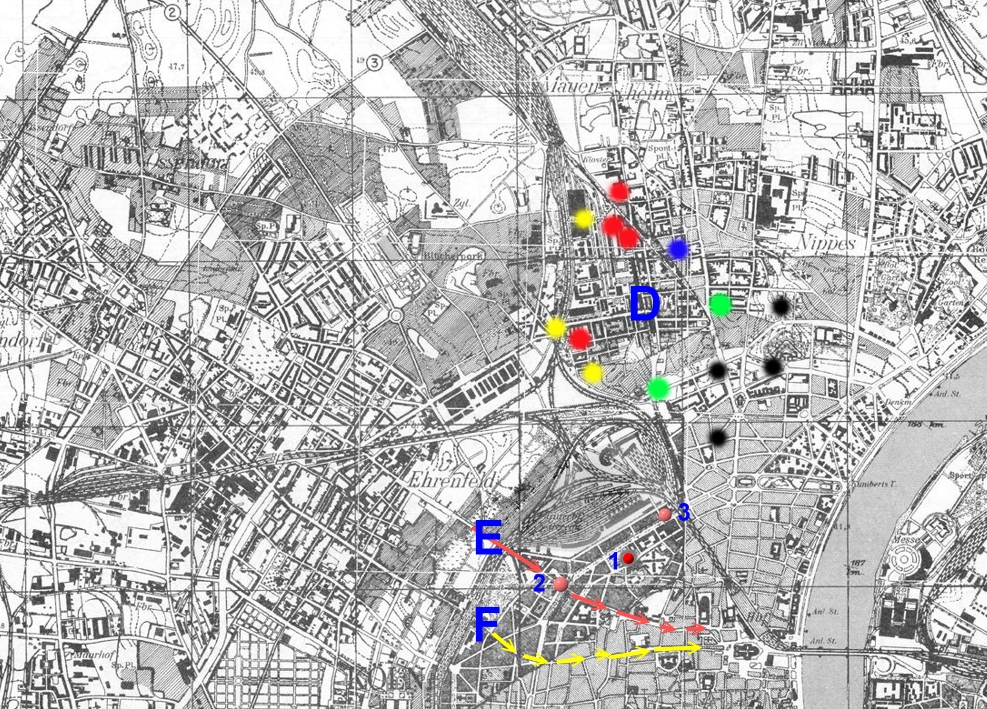
 The locations around the capital letter D for the D Company: 12:05 o'clock (yellow), 12:45 o'clock (red), 13:15 o'clock (blue), 14:20 o'clock (green) and 16:30 o'clock (black). All entries were thus made in the area of the Cologne-Nippes city district. It was obviously a tenacious advance of US troops in this area. The locations around the capital letter D for the D Company: 12:05 o'clock (yellow), 12:45 o'clock (red), 13:15 o'clock (blue), 14:20 o'clock (green) and 16:30 o'clock (black). All entries were thus made in the area of the Cologne-Nippes city district. It was obviously a tenacious advance of US troops in this area.
The yellow line on the veteran's map in the penultimate picture, i.e. the advance of D-Company, fits in well with the location reports marked with the coloured dots.
Here you can see that the D Company has never been in the area of Christophstrasse and at the car of Katharina Esser (2) standing there in the relevant period, in which Katharina Esser is alleged to have been run over.
The Hansa high rise is marked with number (3). With number (1) a location is marked, at which at 14:20 o'clock units of the Taskforce Doan with the Company E had been reported. The latter suggests that it was therefore probably Company E units that had previously crossed the street Hansaring to the west of the Hansa high rise at lunchtime. This is what German soldiers had reported in the Hansa high rise at the time - as written above.
So we can clearly see that the D-Company with the alleged witness involved was still in Nippes at the time when a Sherman was allegedly shot down in Christophstrasse, a good 2 kilometres away. It could have arrived in the area at Ebertplatz at around 16:30 at the earliest, still a long way from Christophstrasse. In any case, D Company never stayed in or near Christophstrasse !
So the supposed proof with the veteran from D Company goes completely nowhere. It is even a particularly full-blown smoke candle and strictly speaking a deliberate falsification of facts. The Veteran and his tank were not at all near Katharina Esser's position when they were shot down. The veteran was shot down with absolute certainty in the district of Cologne-Nippes, about 2 - 3 km away from Christophstraße and thus Esser's position.
Rheindorf brazenly assigns this shooting down to Christophstraße with the local assignment "was in this area" and "Gereon's Quarter", which in truth he invented and only foisted on the veteran, although he had to know exactly the distant positions of D Company on the basis of the US Army documents. He knew that the veteran with D Company was never around, but portrays it that way in the film and book ...
Very brazen ...
This example in particular shows how careful you have to be with the alleged evidence that Rheindorf presents. Much of what looks so simple and clear to the normal viewer is, on closer inspection and scrutiny, a shot in the arm and puts his documentation in a dubious light overall.
Diary entry
Incidentally, in Rheindorf's film, the "first clue" he gave as to what might have happened in Christophstrasse was the above-mentioned report by "the little-known military historian". As we have seen above, however, the first thing that was wrong with this report was the time stated in it. It was therefore clear that the report was not suitable for a book that the reader could look at more closely and for an unlimited period of time. If he had shown the report there, the inappropriate time would have been noticed. In Rheindorf's film, shots were allegedly fired from a house "directly on Christophstrasse". In Rheindorf's book, however, it is a house "directly on Gereonstrasse".
Rheindorf therefore chose a different "first clue" for his book and does not mention the researcher's report at all.
In the book, Rheindorf instead shows two excerpts from the records of the "History of the 363rd Volksgrenadier Division" (363rd VGD) as a "first clue", from which he deduces that a tank was shot down in Gereonstrasse. Even before he shows the clippings, the nails are being cut again! From a house directly on Gereonstrasse, Hpt. Fritz Rose and his tank destruction squad are said to have opened fire on the following US vehicles.
And what do the two text passages shown contain from which he concludes this?
1st text passage:
|
"At around 07:00 the racket starts again. With tanks and infantry, the Americans slowly but steadily approached. Around midday, the Americans cross the Hansaring 100 metres west of our tower block and fire at us with machine guns. We have to retreat slowly. Our hedgehog is getting smaller and smaller. Towards evening we are fired on from three sides. The situation becomes increasingly critical."
|
Immediately after this first passage, which clearly comes from a staff physician Dr Künstle from GR 958, another passage is shown directly below.
|
‘This was followed by heavy infantry fighting, during which Hptm. Fritz Rose, leader of the armoured destruction squad and adjutant of VGR. 959 of the 363rd VGD. shot down two ‘Shermans’ with the Panzerfaust.’
|
This second passage was obviously not written by staff physician Dr Künzle, because he has already completed his account of 6 March 1945. "Towards evening ...". This becomes clearer if you look at the entire passage by Dr Künstle on 6 March 1945 and not just the cleverly abbreviated passage by Rheindorf. The entire passage on the daily routine, which extends into the period after midnight, reads as follows:
|
Firstly, the section shown by Rheindorf again:
"At around 07:00 the racket starts again. With tanks and infantry, the Americans slowly but steadily approached. Around midday, the Americans cross the Hansaring 100 metres west of our tower block and fire at us with machine guns. We have to retreat slowly. Our hedgehog is getting smaller and smaller. Towards evening we are fired on from three sides. The situation becomes increasingly critical."
The text then continues as follows, which Rheindorf does not show in his book:
"We have to hold out until nightfall, then we move off in groups to the Rhine. There we will establish a new line of defence until the order to withdraw comes at midnight and Cologne has to be abandoned to the enemy."
|
Both excerpts, the shortened excerpt by Dr Künstle and the second excerpt are of course cleverly placed one behind the other:
What is being suggested here?
The "Americans cross the Hansaring" in the first excerpt, "Afterwards there were heavy infantry fights" in the second excerpt.
The reader is supposed to conclude from this that the two belong together, so to speak in the chain of thought: heavy fighting at Hansaring, where the tank was shot down ... Hansaring is on the edge of the Gereonsviertel (city district) ... Gereonstrasse / Christophstrasse are in the Gereonsviertel (city district) ... so of course, the tank ran over Katharina Esser in a panic ...
Cleverly ...
But it should be noted that Dr Künzle, the division's operational chronicler, only describes the crossing of the Hansaring by US soldiers, a retreat to the Rhine and the final crossing at night, but no tank firing !
Someone else must have written these lines with the heavy fighting and shooting down of a tank !
I'm looking at the records on the history of the 363rd Volksgrenadier Division (The book "Die Geschichte der 363. Infanterie-Division, 363. VolksGrenadier-Division von Herlmut Gohlke / Ralf Anton Schäfer"), which Rheindorf apparently refers to. I cannot find the text of the second excerpt in it. Instead, the book contains the 363rd:
|
"In the afternoon, a strong enemy group with armoured support penetrates the last small bridgehead. Hptm. Rose (Adj. GR 959) manages to seal off the break in with quickly gathered men and bazookas, shooting down a tank in the process."
|
Aha, a break in sealed off ...
Whether the excerpt from an unknown source by Rheindorf as well as this actual excerpt from the historiography of the veterans of the 363rd refers to an event at Hansaring at all seems extremely questionable. I am only too familiar with Rheindorf's often dubious evidence, which also appears very manipulative here with the combination of the two excerpts. This rings all the alarm bells for me again. There is no specific reference to either Gereonstrasse or Christophstrasse in any of these 3 excerpts.
US troops have crossed the Hansaring, that's all there is in terms of location information. And the second excerpt shown by Rheindorf only says that there was heavy fighting somewhere, but not where. The clipping can refer to all kinds of events in Cologne on that day.
This "proof" reminds me of the comments on the veteran who, according to Rheindort, was supposed to have been in the Christophstrasse area, but who must actually have been shot down in the more distant city district of Nippes.
Here again the insinuation that the Americans were shot at in Gereonstrasse ! Reader, eat or die !
Hmmm, let's take a look at an aerial photograph of Cologne in 1945 from the west:

 Source: NARA. Here we see the Hansahochhaus marked in yellow on the left with a section of about 150 metres of the Hansaring (100 metres west of the Hansahochhaus (highrise) the Americans are said to have crossed the Hansaring - white arrow next to it) and on the right with a red dot the place where Esser's car was hit. Gereonstrasse is marked in green in the background. The white arrow on the right shows Gladbacher Strasse, where the troops came along with Smoyer's tank and the cameramen. Source: NARA. Here we see the Hansahochhaus marked in yellow on the left with a section of about 150 metres of the Hansaring (100 metres west of the Hansahochhaus (highrise) the Americans are said to have crossed the Hansaring - white arrow next to it) and on the right with a red dot the place where Esser's car was hit. Gereonstrasse is marked in green in the background. The white arrow on the right shows Gladbacher Strasse, where the troops came along with Smoyer's tank and the cameramen.
This picture clearly shows how absurd Rheindorf's conclusion is that the crossing of the Hansaring next to the Hansahochhaus alone indicates that a tank was shot down by Hptm. Rose from an ambush in Gereonstrasse. There is no line of text that proves this connection. It is simply the crossing of Hansaring / shooting down in Gereonstrasse that is presented to the reader of the book. The aerial photo shows how absurd it is to talk about a launch just from the crossing of the Hansaring in a part of Cologne city centre several streets away. And how could Katharina Esser have been run over by a tank in Christophstrasse in a panic reaction to a tank being shot down in Gereonstrasse? That is complete bollocks in theory alone!
And in Dr Künstle's excerpt, after the Americans had crossed the Hansaring, it also says: retreat and then to the Rhine. This retreat is more likely to have taken place in the direction of the blue arrow if the Americans had already advanced west of the tower block. This corresponds more to a retreat perhaps in the direction of the northern city district Kunibertsviertel (blue arrow at the top of the aerial photograph) and not to any localised movement towards Gereonstrasse.
And let's take another look at the previously presented section from the historical chronicle of the 363rd VolksGrenadier-Division. It also mentions Hptm. Rose, who is said to have been so successful in shooting down tanks:
|
"In the afternoon, a strong enemy group with armoured support penetrates the last small bridgehead. Hptm. Rose (Adj. GR 959) manages to seal off the break in with quickly gathered men and bazookas, shooting down a tank in the process."
|
"seal off the break ...", hmmm
This description does not fit at all with a shooting in the Gereonsviertel!
Because by around 12 noon, Smoyer's tanks and other tanks had already reached Christophstrasse and were then travelling on towards the cathedral. It would have been complete nonsense if an attack had been carried out in Gereonstrasse on advancing US troops, because then the first forces would inevitably have already been in the banking district behind Gereonstrasse, i.e. very close to the centrally located cathedral !
So this was not at all about having "sealed off" a break-in. Nothing was "sealed off" or even stopped by the use of a bazooka by German soldiers. The "sealing off" mentioned in the chronicle, i.e. preventing American troops from breaking into Cologne could not have taken place on Christophstrasse or Gereonstrasse, as the Americans were already "inside".
And therefore this "sealing off" by Hptm. Rose and his men must necessarily have taken place in another area of Cologne - not at least in the area around Katharina Esser.
So where could Hptm Rose's Panzerfaust mission have actually taken place?
Probably here:
In the districts of Cologne much further north of Christophstrasse, such as Nippes and Niehl, which were 2 - 3 km away, the US Army had major problems all day with the advance into the city centre. Rheindorf himself even devotes a separate chapter to these battles in his book under the heading "The US combat troops are stuck" !
Rheindorf writes with reference to the battle reports of the Americans in the book (here in a shortened but meaningful presentation):
"As the battles continue, the US reconnaissance planes note that the German lines of defence ... are being reinforced.
H Company of the 3rd Armoured Division loses three tanks not far from the railway facilities in Nippes ...
Until noon, the Americans try to break through without success. Units of the 9th Armoured Division, the 363rd Volksgrenadier Division ... have dug in ...
After reinforcements arrive for the spearheads, the Americans attempt an assault over open terrain at 14:00 - unsuccessfully, two more tanks are lost.
Only in the evening, when the defenders retreat ... the GIs managed to penetrate Nippes and the Agnes city districts neighbourhood."
|
As a reminder, Hptm. Rose was a member of the 363rd Volksgrenadier-Division, the unit that had entrenched itself in the northern part of the city and where the US troops were held up!
In his book, Rheindorf describes in other words exactly what can be described as a real seal off by the Germans.
The Americans make little or no progress there and even lose several tanks (one of them probably the very tank of Stuart Thayer, already introduced in the chapter ‘The Veteran’ above).
In the US deployment report on the fighting there, which Rheindorf also shows in the book, there is also mention of the use of "AT" by the Germans. These are "anti-tank" weapons such as bazookas ...
To finally settle the question of Fritz Rose's alleged shooting in the Gereonsviertel district, I consult Ralf Anton Schäfer, historian and co-author of the aforementioned chronicle of the 363rd Infantry Division and 363rd Volksgrenadier Division. Who knows more about the history of the division to which Fritz Rose belonged than he does?
It turns out that he actually walked through Cologne with Fritz Rose on two occasions in the 1990s and talked about the events of that time on the spot! The information about Fritz Rose's mission in Cologne on 6 March 1945 could not be more direct and credible than what Ralf Anton Schäfer then writes to me!
|
"On 6 March, infantry fighting broke out in the Hansaring area. That is probably correct, but I categorically deny that Rose fired a bazooka in that area."
|
Schäfer continues:
|
"I would like to place the tank shot significantly further to the north-west, adjacent to the southern edge of Weidenpesch. Twenty metres west of the B-9, at the intersection of Friedrich-Karl-Straße towards the cemetery."
|
This area is located in the Mauernheim/Nippes district, which is much further north-west than the area in the Gereonsviertel district!
This corresponds 100% to my assumption, already expressed above, that Rose was active in the northern districts, especially in the Nippes district, and that there was actually where an American Sherman tank was shot down, and not in the Gereonsviertel, as Rheindorf insistently claims. Fritz Rose was never in the areas Gereonsviertel, Christophstrasse or Gereonstrasse with his Panzerfaust!
Schäfer even goes into detail about the Sherman tank being shot down by Fritz Rose at that time:
|
According to Hauptrmann Fritz Rose, his small combat group approached the intersection of Friedrich-Karl-Straße and B-9 (Rennbahn-Straße) from the south. Already as they approached, enemy (tank) fire was directed at the intersection to the east, where tanks of the 9th PD were located.
When a Sherman suddenly drove into the intersection, stopped briefly and opened fire to the northeast, Rose ordered the group to take cover and engage the enemy. The first volley of fire from the ‘stovepipes’ missed its target, and a second volley failed to materialise due to misfires.
Immediately, Rose grabbed a bazooka and fired at the enemy tank from a distance of about 30 metres, hitting it in the front right track area. The tank rolled backwards, threw off its track and remained immobile, while continuing to fire.
When Rose's group reached the tank, according to his statement, the vehicle had been abandoned; the crew was not found at the tank and could not be located.
The group then secured the immediate area and pursued the enemy. A brief infantry skirmish ensued, during which two US infantrymen were taken prisoner. The incident was reported to the division via the regiment; in this context, Fritz Rose was nominated for the Knight's Cross because the shooting had stabilised the situation in the area for a certain period of time."
|
This account by Ralf Anton Schäfer, which he received from Rose herself, is absolutely clear!
All of Rheindorf's claims that Fritz Rose shot down a Sherman in Christophstrasse or Gereonstrasse have now been conclusively refuted.
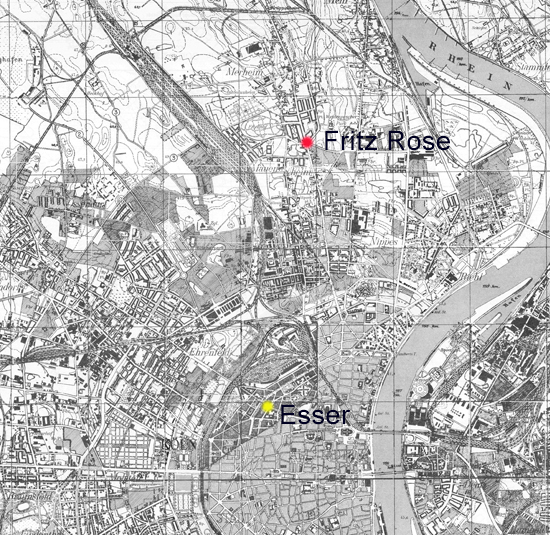
 Red: Rose's position when the Sherman was fired upon, yellow: Esser's position. Far apart in the urban area, about 3.5 kilometres / 2.2 miles as the crow flies! Red: Rose's position when the Sherman was fired upon, yellow: Esser's position. Far apart in the urban area, about 3.5 kilometres / 2.2 miles as the crow flies!
Even though a bazooka attack by Rose in Christophstrasse or Gereonstrasse has now been conclusively disproved:
Another thought also shows how absurd the theory is that a house on Gereonstrasse or Christophstrasse was shot at advancing troops with a bazooka. At the very front of the advancing troops, all the houses were searched individually by American infantrymen for resistance fighters. This was a time-consuming process that was documented many times in films and photos in Cologne. These house searches are also briefly shown in the film images from Christophstrasse or previously in Gladbacher Strasse. They also swarmed into the side streets and searched the houses there.

 Infantrymen search the houses for German resistance fighters. Infantrymen search the houses for German resistance fighters.
For this reason alone, it is hardly conceivable that an armed troop of German soldiers with a bazooka could still have been in these houses in the neighbourhood of Christophstrasse.
Because if he had been there the whole time, why did he not shoot at the very first arriving US units and tanks, but allegedly at advancing troops? Gustav Schäfer had also testified that he had been alone in the area with his tank as a defender, so he had not seen any other German soldiers.
So before, when the area was still in German hands, Hptm. Rose was certainly not there.
And afterwards, when many tanks and soldiers had already passed through, the area around Christophstrasse was already securely in American hands. How was a whole troop of German soldiers supposed to get there unnoticed, right through the American lines ?
And what was such a launching action on retreating troops supposed to achieve at all ? The US troops were already past the top, shortly before the Cologne Cathedral, what would the shooting down of a single US tank have achieved ?
And why should Hptm. Rose and his men be in this area of the Gereon district at all, when the US troops here in the west of the city, as well as the US troops further south, had long since been on their way to the cathedral, when at the same time there was still heavy fighting in the northern parts of the city and his own military unit was still massively defending them for hours? He was much more needed there.
Such a German military action in the Christophstrasse would have been absolutely pointless in view of the combat situation in Cologne at that time!
And it would also have been a kamikaze operation ... An action in the middle of the area already occupied by the Americans, actually no possibility of escape. But Hptm. Rose survived Cologne...
What is also striking is that Rheindorf does not present any battle reports or military documents from the Americans that document the firing of a Sherman in Christophstrasse or Gereonstrasse. And according to Rheindorf in his book, there are supposed to be thousands of pages from the Americans documenting the military capture of Cologne.
He found the losses of 5 tanks in the north of Cologne above, the Sherman that was shot down in Komödienstrasse can also be found in the documents of the troop units that moved to the cathedral via Venloerstrasse and Gladbacher Strasse / Christophstrasse.
However, in these news reports of the US troops advancing via Christophstrasse / Gereonstrasse there is no loss reported of a tank in Christophstrasse or Gereonstrasse!
The bottom line: even this alleged evidence of "firing by Hptm. Rose" in Gereonstrasse is not valid. A Panzerfaust action on advancing US tanks was absolutely pointless. No firing by the Americans was documented either. In the northern parts of the city, however, such an action could actually stop the advance of the US troops for hours.
So Hptm. Rose did not shoot down a tank in Gereonstrasse that afternoon, let alone in Christophstrasse.
No tank firing, no panic, no panic-induced rolling over of Katharina Esser ...
Again, it is cheeky that Rheindorf simply claims that Hptm. Rose shot from a window in Gereonstrasse without any more precise, real evidence... This is simply unbelievable, but fits in perfectly with his other evidence ...
The jeep
Another alleged proof of Rheindorf is another photo from the Christophstrasse area, which Rheindorf shows in his book. It shows a jeep at the junction of Von-Werth-Strasse and Christophstrasse.

 Source of the same picture: Walter Dick Archiv/Bilderbuch Köln. Source of the same picture: Walter Dick Archiv/Bilderbuch Köln.
Rheindorf writes: "An US jeep damaged by shelling in the middle of the intersection Christophstrasse / Von-Werth-Strasse". The intention of this presentation of the picture is clear. It is supposed to prove that a new battle actually took place there later, in which the jeep was damaged ...
Well, damaged by shelling ?
The jeep doesn't look like a tank drove over it in panic or crashed into it. If it was hit by a bazooka, the car would also look really destroyed. There are no destroyed parts of the jeep next to the car and the 3 recognisable tyres don't have a flat either.
But the jeep indeed looks different from other US jeeps at first sight. Is that already the supposed "damage", that it looks different ?
A little research shows. There are Jeeps that look like this, it is a kind of transport Jeep.
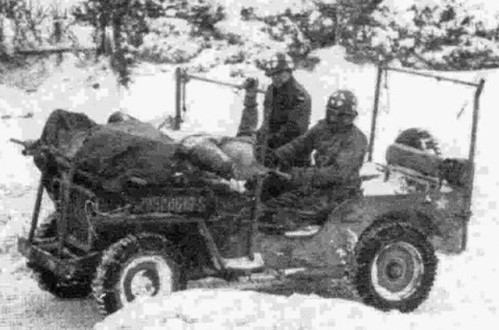
 source 324th Medical BattalionUnit History. In the front area of these jeeps is a rack on which items could be transported. The jeep was also used by medical units, for example. The photo shows such a use. source 324th Medical BattalionUnit History. In the front area of these jeeps is a rack on which items could be transported. The jeep was also used by medical units, for example. The photo shows such a use.
And the jeep in the photo looks very similar to the jeep in Cologne, the attached transport frame is clearly visible. There are objects on the frame, which could very well be rolled-up stretchers. The front bumper bar is hanging at a slight angle in the photo, but this is probably normal wear and tear caused by travelling through rough terrain or rubble.
Anyway, I don't see any evidence of a previous extraordinary combat situation with shelling of this jeep either. Probably the jeep was just standing there at that time when the photographer was there .... Maybe the wounded Esser was even transported away with this jeep afterwards ?

 Image sources: NARA / John Florea - LIFE Photo Collection / Walter Dick Archive Image sources: NARA / John Florea - LIFE Photo Collection / Walter Dick Archive
A small photomontage of several photos that makes the position of the jeep (yellow marked) clearer. On the left is the destroyed German car, on the right is another jeep with 4 soldiers in Christophstrasse. In addition to the normal jeep, there are also other jeeps and a motorbike in the background on the right in front of the entrance to the Gerling Group office building there. Presumably the jeeps were all simply parked there temporarily, and an initial assembly point had probably been set up in the Gerling Group office building there. Several soldiers are gathered in front of the building, several soldiers are discussing the jeep.

 Source excerpt: John Florea - LIFE Photo Collection Source excerpt: John Florea - LIFE Photo Collection
The assembly of soldiers, jeeps and motorbike in background in front of the office building in Christophstrasse.
It is also possible that the transport jeep was there because it was to be used to remove the remains of the bodies lying around on the road there or the bodies of Delling and the driver of the third car.
There is nothing to suggest that the jeep seen in the picture has been damaged by any emerging fighting.
Even this alleged proof is no proof ...
Summary of Rheindorf's various alleged evidence
In summary, none of the alleged evidence of resurgent fighting in Christophstrasse has stood up to scrutiny.
It can therefore be assumed that the American tanks were able to drive through Christophstrasse without any further problems and passed in the direction of the cathedral. There was no panic situation with advancing tanks, which could have led to Katharina Esser being accidentally rolled over by a tank.
So we return to the affidavit.
The affidavit of the alleged witness - why ?
|
Let's take a brief interim stocktaking.
From the historical record, there is only the affidavit, which simply states in very short words that Katharina Esser was run over by a tank while lying shot in the street.
That's all the affidavit says.
Hermann Rheindorf alone has now claimed that fighting flared up again in Christophstrasse. In doing so, he wants to make it more credible that a tank could actually have rolled over Katharina Esser in full knowledge. In particular, there are no American mission logs or other sources proving that a Sherman was shot down in the Christophstrasse.
According to no known source, there was no flare-up of fighting in Christophstrasse, and Rheindorf's alleged evidence is worth nothing.
But if there was no more fighting and the tanks were able to pass the area without any problems or had even already left, why should Katharina Esser have been run over by a tank at all ?
And that brings us to the core of the question:
Is the affidavit even correct, was Katharina Esser even run over by a tank ?
|
Well, after all this I am NOT convinced that Katharina Esser was really run over by a tank in a sudden combat situation as Rheindorf claims. It is and remains a pure speculation, which I would not consider in the least as proven by the alleged "evidence" brought in by Rheindorf, which for me run into the void.
There is no clear evidence that German soldiers fired at a tank in Christophstrasse after 12 noon, causing such a panic that Katharina Esser was run over by an US tank.
Now, why did the witness testify before the police the way she did ?
Possibly the witness did not see at that time in detail how everything happened, especially whether Katharina Esser was run over. It is possible that she only noticed something in passing and then drew conclusions from it for an alleged overall course of events. Possibly she has seen e.g. the body remains of persons on the street, to which Rheindorf had already asked the question whether they would come from Esser. And then the witness simply assumed that, after many tanks had passed this piece of road, that one of the tanks could have run over Katharina Esser. When she looked there, Esser had probably already been taken away and the body parts were lying around, which could already be seen in the film before.
It is also possible that the remains of the body, which according to what has already been determined above, were lying there on the street before the Esser car was shot at (i.e. came from dead people in the other car) when driving past later the tank was actually run over by one or more US tanks.
The reference to the boots in the affidavit could then also become clearer. This is because boots can also be seen between or on the torn body parts on the road. The special reference to boots in the affidavit already allows the conclusion for me that the witness perhaps only attached it to these boots that she thought the Esser had been run over there on the street by a tank.
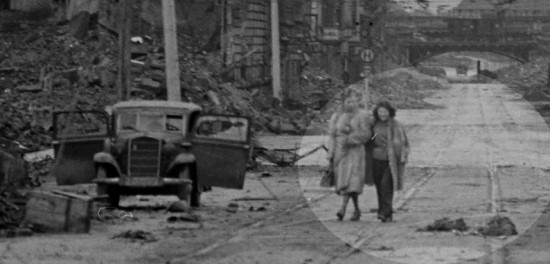
 source: John Florea - LIFE Photo Collection source: John Florea - LIFE Photo Collection
On a photo from the time when Katharina Esser is already not lying next to the car anymore, in the afternoon, two civilian women are walking across Christophstrasse. They are looking at the body parts on the street, where there are also boots. Maybe one of the women even happens to be the witness in question who later makes the affidavit ?

 Torn corpse parts with boots lay around on the street, here the corpse parts which the two women had looked at in the last picture. This may possibly have caused the witness then also to the purposeful explanation to mention especially the boots which Katharina Esser is supposed to have worn then. Presumably, the witness was asked how she would determine that the body remains found there would come from Esser. And presumably it was then simply up to the witness to mention that Esser had been wearing boots in order to be able to prove the death clearly from her point of view. Or maybe the police investigating the disappearance of Esser had even explicitly inquired or asked whether the body parts with the boots had been from Esser (just as Rheindorf had also asked in the first version of his film documentation whether the body parts could be from Esser). Torn corpse parts with boots lay around on the street, here the corpse parts which the two women had looked at in the last picture. This may possibly have caused the witness then also to the purposeful explanation to mention especially the boots which Katharina Esser is supposed to have worn then. Presumably, the witness was asked how she would determine that the body remains found there would come from Esser. And presumably it was then simply up to the witness to mention that Esser had been wearing boots in order to be able to prove the death clearly from her point of view. Or maybe the police investigating the disappearance of Esser had even explicitly inquired or asked whether the body parts with the boots had been from Esser (just as Rheindorf had also asked in the first version of his film documentation whether the body parts could be from Esser).
As the photos of the Esser lying on the ground show, she was lying very close to her car, the legs/feet were probably even under the car. It already does not seem comprehensible that the witness could then from some distant position even recognize what the Esser was wearing that day, especially the footwear:

 Feet / footwear are not recognizable even on the closer film images ... Feet / footwear are not recognizable even on the closer film images ...
In my view, these sentences in her affidavit in particular show that the witness in Christophstraße at the time did not in fact witness a great deal:
| " ... the owner was killed by a head shot and the employee, who was trying to look after her boss, whereby she was also shot at and fell down sideways next to the car. The employee was then run over by the tank so that afterwards only remains as well as hand, foot and some body remains were to be found ..."
|
How and where did Katharina Esser make an effort for her boss ?
That Esser lay motionless on the passenger side with her injuries is irrefutably established. This can be seen on the film pictures. But no tank could pass there because of lack of space and because of the house debris. The car and the car door were clearly undamaged when Florea took his photos in this street section and Esser was no longer lying there. So clearly there was no running over of the woman on the passenger side.
And crushed body remains (as WE know from the person from the other car) lay on the road after passing the American tanks on the driver's side of the car ...
Therefore, the alleged witness simply thought up a story about how she could coherently assign the body remains of the woman from the car. And there was only one possibility. The woman must have gotten out of the car and gone to the driver's side to "take care" of her boss. After all, the driver's door is open in Florea's later photos, and the boss is sitting dead in the driver's seat. The door open as if someone was looking after him. With a shot in the head, he could not have opened it himself.
And in this effort the woman was then shot and fell hit "sideways" next to the car. There she lay in the middle of the road and the tanks that subsequently drove across the road must have simply rolled over her in the process, turning the woman into the muddy remains of her body with boots on the road.
What the witness came up with, once visualized in this photo montage:

 Tank shoots at car - so far also reality ... Tank shoots at car - so far also reality ...

original source: John Florea - LIFE Photo Collection
 Woman runs around car, takes care of driver, gets shot, falls sideways next to car, gets run over by tank ... Woman runs around car, takes care of driver, gets shot, falls sideways next to car, gets run over by tank ...
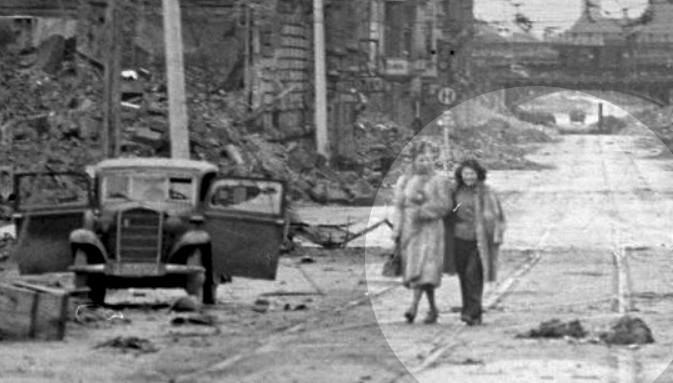
source: John Florea - LIFE Photo Collection
 After being run over by tanks, in the witness's conclusion, pieces of the woman's body are left lying on the road ... The driver's door is open, so Esser - in the witness's imagination - was probably looking after the driver on this side, the window of the driver's door is shattered, this was then caused by the shot that hit Esser while he was standing on the driver's side. After being run over by tanks, in the witness's conclusion, pieces of the woman's body are left lying on the road ... The driver's door is open, so Esser - in the witness's imagination - was probably looking after the driver on this side, the window of the driver's door is shattered, this was then caused by the shot that hit Esser while he was standing on the driver's side.
For the witness, this was probably the only plausible explanation for the situation she later found herself in and led to her affidavit.
But it clearly does not match the film images and photos of the American cameramen (which the witness almost certainly did not know at the time). There Esser lay just badly injured on the passenger side. And she fell out of the car, where she remained, seriously injured shortly after being shot at. So no wanting to help the boss and only then being hit by bullets.
Thus, in reality it looked like this:
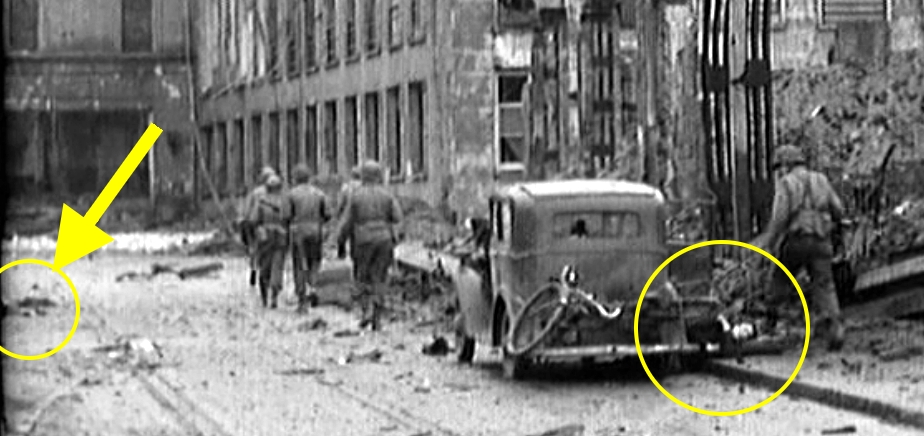
 Katharina Esser injured on passenger side, right circle, body parts from the occupant of the car on the other side of the road are already lying on the road at this time, arrow ... Katharina Esser injured on passenger side, right circle, body parts from the occupant of the car on the other side of the road are already lying on the road at this time, arrow ...

 The body parts, right arrow, from the occupant of the other car, left arrow ... The body parts, right arrow, from the occupant of the other car, left arrow ...

source: John Florea - LIFE Photo Collection
 Esser has already been taken away. Two women look at the body parts that are not Esser's, but from the other car's occupant on the right side... Esser has already been taken away. Two women look at the body parts that are not Esser's, but from the other car's occupant on the right side...
And the affidavit at the police also appears so dispassionate, that from my point of view it also does not result that this running over could have happened from a dangerous situation like a sudden firing by a bazooka. According to the witness, the woman fell "sideways" next to the car and was run over by "the tank" ... finished ...
Wow, it can hardly be shorter ...
Also strange: according to her statement she knew that Esser was an employee and the driver was her boss.
How should she be able to say that from her own, uninfluenced knowledge ? Obviously she did not know both persons at all and knew that they were employees and boss ? Esser and Delling did not live in this part of the city before.
This all speaks rather for the fact that appropriate messages were already made to her before, which then influenced or even steered her statement ...
Also she recognizes "the girl again" when giving the statement ...
How can that be ? Which photo was presented to her for recognition ? A family photo, a picture from the film scene of the US Signal Corps ? And with what was compared ? Did she really see the face of the woman who had fallen out of the car from a great distance ? Probably not ...
Then, in reality, she surely did not recognize the face at all and thus did not really identify the person. How then also: from a body, which consisted after the alleged running over by a tank only of "rest pieces as well as hand, foot as well as some body remains" ? There is no mention of a head in this enumeration either ...
In addition, the handwriting of the declaration differs from the signature and address of the witness below the declaration. As curved and almost artistically written as the declaration is, the signature and address details are minimally sparse. In the declaration, the street name is misspelled as "Christofstrasse", but in the address under the signature, sure written by the witness, it is spelt correctly as "Christophstrasse". The declaration was therefore not written by the witness. The date of the declaration and the police officer's notarisation are curiously enoughone day apart.
So, this affidavit is really very curious. It seems that the Cologne police did not really want to do an extensive clarification.
Esser's family in particular naturally had an interest in finding out the whereabouts of Katharina Esser. As she no longer appeared, death was probably the obvious conclusion, but this was not officially confirmed months later.
After the war, the search for missing persons and the handling of death certificates for missing persons was also difficult in Cologne and was strongly characterised by the chaotic post-war conditions and the need to rebuild the police force. Authorities were faced with the problem that there was often no clear evidence of the death of a missing person.
Without a corpse or official confirmation, a death certificate could not simply be issued.
However, it was helpful if there were credible indications, e.g. statements from witnesses!
So a witness statement was needed to be able to file the case and finally clarify Katharina's whereabouts.
How fitting that the testimony of the witness confirmed the death of Katharina Esser and then so clearly, she was shot at by tanks, run over by a tank, woman recognised ...
And then it happened very quickly, already on 19 January 1946, only 3 days after the witness's declaration, the death certificate arrived!
| 16.01.1946 | Affidavit |
| 17.01.1946 | Notarisation by police officer |
| 18.01.1946 | Notification of death from the police to the registry office |
| 19.01.1946 | Creation of death certificate at the registry office |
How exactly the police got hold of the witness remains unclear. In any case, she was there almost a year later, at the police station. Perhaps they were looking for people in the neighbourhood with the question of who was generally in the vicinity of the events at the time and she, as a resident of Christophstrasse, came forward.
Presumably, the statement was more or less put into the witness's mouth in order to finally close the case. A tiresome procedure from wartime. Nicely resolved by the fact that the victim was simply run over and identified. No further elaborate investigations necessary ...
And what should also come out at the end of long investigations ? Who else should be held responsible for the death of Katharina Esser. The US Troops, the war winners ?
A quick, supposedly clear affidavit at the end of the investigation for the file, that's what the police wanted and that's what they got ...
Maybe the witness really heard or saw something on the morning of 6 March. There was shooting, the sound of tanks, tanks driving past the house. But it seems to be more a matter of pure deduction than something that really happened in this form. I am convinced that she certainly did not see Katharina Esser being rolled over by a tank because, after assessing all the circumstances, this is not how it happened ...
What happened with Katharina Esser
What actually happened to Katharina Esser on that day after the last filming ?
As the only concrete written document on the subject of the death of Katharina Esser, there is only the affidavit of the witness.
The other allegations and alleged evidence which Rheindorf added to an overall picture he favored and which have been closely examined above, must be regarded as inaccurate or at least classified as extremely questionable.
It gives the impression that Rheindorf preferred to prove with all his might that Esser had been run over by a tank rather than "simply" having died from the injuries he had suffered. Of course, the story with the tank is easier to sell ...
However, according to the above, the affidavit is useless for clarification because it is not consistent and does not correctly reflect the actual events. It must be assumed that the witness did not actually know very much about what happened in Christophstrasse and merely put together individual pieces of the puzzle as she saw fit or was guided by the police to a certain explanation.
The picture of John Florea, which he quite obviously took when the fighting units with the other cameramen had already moved on to the banking district, i.e. also at a point in time of which Rheindorf claims that the fighting on Christophstrasse had sprouted again there and Esser had been run over, shows in my opinion best what actually still happened on Christophstrasse that afternoon.
Once again: the photo was taken after the withdrawal of the cameramen who had filmed Esser still lying on the ground and who had moved on with the front combat units in the direction of the cathedral:
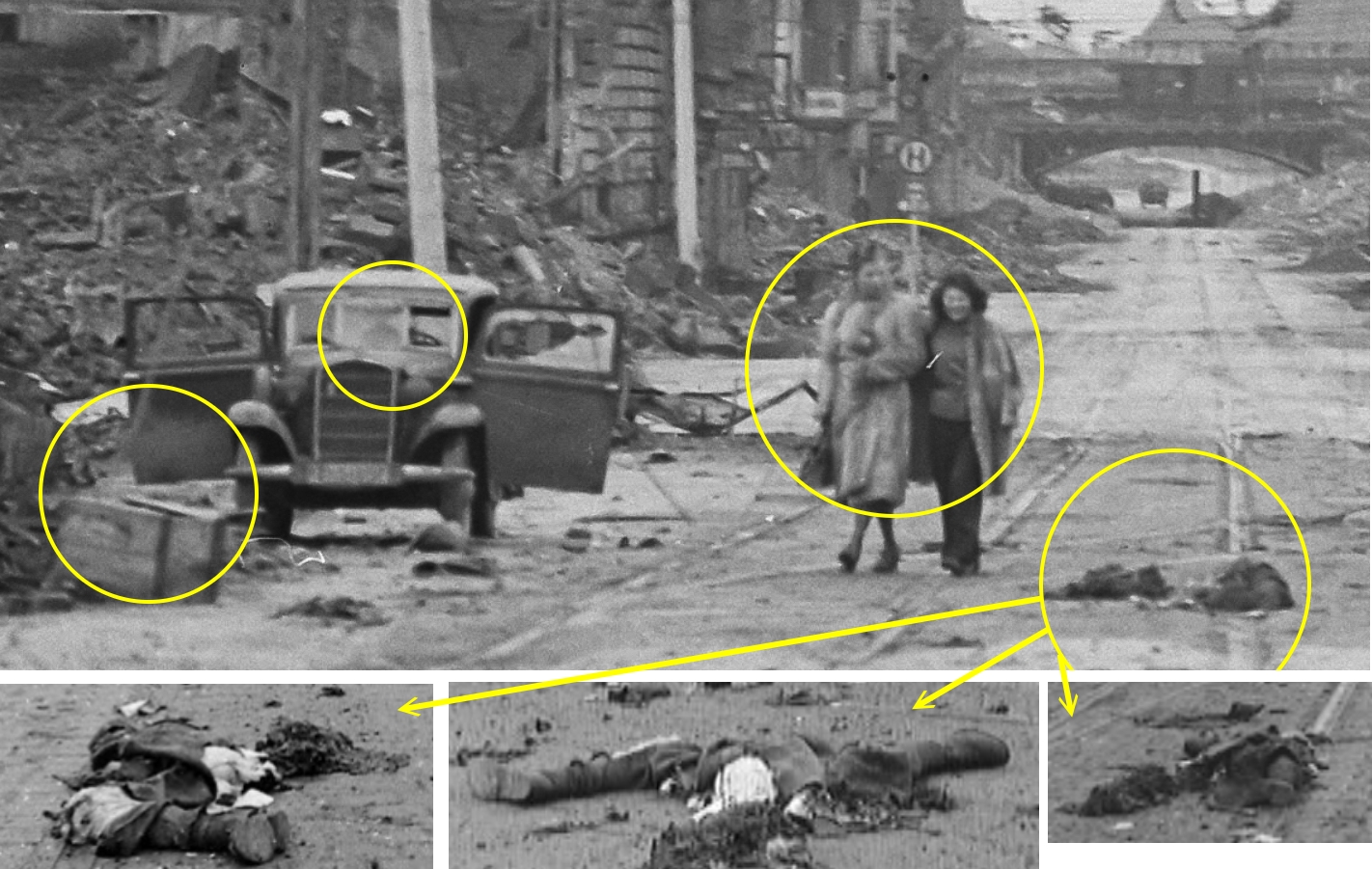
 source: John Florea - LIFE Photo Collection and NARA source: John Florea - LIFE Photo Collection and NARA
Four key findings in one photo:
1.) Esser is no longer lying next to the car.
2.) The driver Delling is still sitting dead on the driver's seat.
3.) Two civilian women in fur coat are walking leisurely along Christophstrasse and at this moment they are looking at the crushed human torso lying in the middle of the street not far from Esser's car.
4.) And just the crushed human torso lying on the street. Under the big picture three smaller, different angles on this torso.
It is easy to imagine that one of the two women is actually the later witness (who lived there in Christophstrasse). Clothing and the fact that they are walking slowly on the street leads to the assumption that they have their apartment in this area and "want to take a look" at what has happened in their environment after the passage of the US troops.
The torso gives the impression that a tank drove over it. If one know (from wherever) that there was also a woman sitting in the car next to the dead driver and that she is now no longer there, but next to the car with the open driver's door lies a torso wearing boots, an observer of the scene on the ground that morning can certainly draw the conclusion that the torso must be this woman.
However, we know from a close examination of all the film images that the torso was not Esser but a soldier from the destroyed other car in the intersection.
Together with the formulation in the affidavit that Esser still wanted to help the driver, then was hit by bullets and fell next to the car, where she was then run over by the tank, this results in an explanation for the formulations in the affidavit of the witness that is obvious from my point of view.
It sounds exactly like a short version, but it also fits exactly with the photo of John Florea.
In the dangerous situation of fighting US troops and the German tank at that time, the witness certainly did not notice very much of what happened in detail that morning.
But she probably knew already at that time or only through later information that there was still a woman in the car. From the things she then saw at the scene, it was not far to the conclusion in the affidavit.
Presumably, she simply concluded that Esser had gone to the driver's door to help the driver, then had been hit and had fallen down toward the road. After all, that would explain the torso being on the driver's side of the car.
There she was run over by a tank, so that only a crushed torso remained of her. And the torso wore recognizable boots, by which Esser then wants to have recognized her, among other things. The emphasis in the affidavit that the woman was wearing boots, the only thing still recognizable about the torso, thus becomes comprehensible.
In fact, however, this scenario did not exist.
Katharina Esser sat injured in the car next to the dead Delling for a long time, then lay on the passenger side next to the car for treatment and was then quite obviously already taken away when John Florea took his photos in the Christophstrasse area.
The car was undamaged on the street when Florea's photos were taken - apart from the hits by bullets. No tank panicked by sudden fire had moved, destroyed, or run over it. The driver, however, was dead in the car. Except for the well-known crushed body of the occupant of the other car, no other human bodies are visible on Florea's photos (he took several shots there) on the road there near esser's car. Also no shot down US tank is to be seen there.
Knowing that dead civilians were still lying around everywhere in the city days later and that Delling was also still sitting dead in the car, but Esser was no longer lying next to it, this allows only one conclusion in my opinion:
Esser is no longer to be seen there, because she has been taken away.
And probably in a living state ! A dead Esser would - like many other dead civilians in the area, Delling included - probably still lie on the spot. In her case dead next to the car on the passenger side.
Initially, three people could be seen next to Esser in the film images:
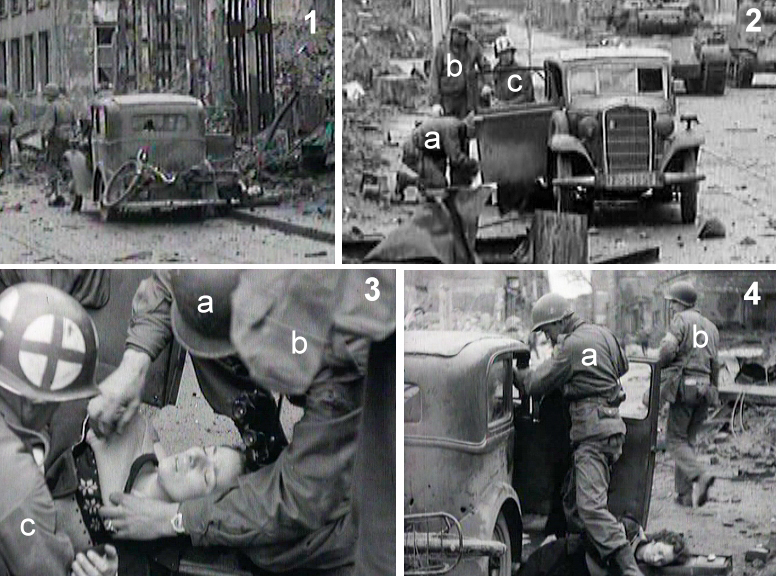
 Image 1: Esser lies on the ground before receiving his first medical treatment. Infantrymen walk by, unimpressed. Image 1: Esser lies on the ground before receiving his first medical treatment. Infantrymen walk by, unimpressed.
Picture 2: 3 people near Katharina Esser. Soldier a kneels next to her, a medic c and another soldier b with a large shoulder bag stand next to her.
Image 3: Medic c and soldier a kneel next to Esser. Soldier b is standing, visible at the right edge of the picture.
Image 4: Paramedic c is no longer visible, soldier b is just leaving and soldier a is still at the car to put a jacket over Katharina Esser's upper body.
The treatment seems to be completed as far as possible in these minutes.
The photos of John Florea, which were taken a little later, when the fighting units had already moved on towards the cathedral, show that there were more medics in the area and that they were even at Esser's car.
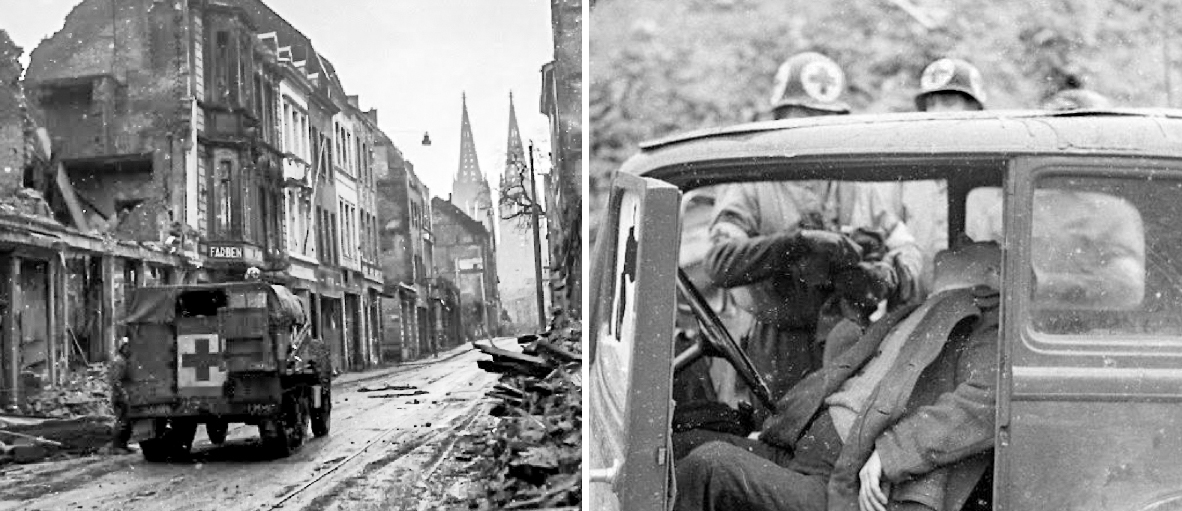
 image detail source: John Florea - LIFE Photo Collection image detail source: John Florea - LIFE Photo Collection
On the left you can see an M3 Ambulance Halftrack vehicle on Christophstrasse and at the car of Katharina Esser there are 3 paramedics. However, Esser is no longer lying there at this moment, as the other pictures of Florea show, so she has already been transported away.

 source: Wikipedia / NARA source: Wikipedia / NARA
Photo of a M3 Ambulance Halftrack vehicle, which was intended for transporting injured people.
So that all speaks for a removal in living condition.
A single exception could conceivably be made for removal in a dead state.
She was a woman and if she died on the spot, maybe they didn't want to just leave her dead there on the sidewalk.
In addition, it is possible that even more paramedics or an ambulance had been called to the place to treat or transport away Esser and these then took a dead woman exceptionally also, because they were now already there and the woman was their concrete target. But this is pure speculation.
Finally, the statement made by Katharina's sister Anna Lettau in an interview with Hermann Rheindorf in 2007 speaks in favor of a removal. In the passage of the interview, which does not appear in the film or book and will not be published by Rheindorf until 2025, she says that at the time the parish priest of St. Gereon claimed to have known nothing about a woman buried in the cemetery there during the family's search for Katharina in 1945, even when asked several times. Delling, however, was buried there. So if Katharina Esser was indeed not buried there together with Delling, she could only have been transported away, presumably alive.
Thus, after all this, three findings remain on the subject of Katharina Esser.
1.) Esser was not run over by a tank, but she was taken away from the place Christophstrasse.
2) Probably she was even transported away alive. But it can not be completely excluded that she already died on site and was then transported away.
3) Katharina Esser did not appear alive anywhere after that. As a result of the sworn statement of the witness, her death was officially established and a death certificate was issued.
More about Katharina Esser
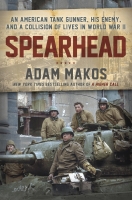 | Adam Makos, New York Times bestselling author of "A Higher Call", has written a book about Pershing's gunner, Clarence Smoyer and his experiences during World War 2. As part of the research, I was able to accompany Adam and Clarence on a visit to the original sites in Cologne, Germany. There he also met the gunner of a German tank, Gustav Schäfer, whom he had faced during the advance in Cologne. The image link leads to Amazon's website, where the book can be ordered. The book also deals with the events surrounding Katharina Esser. Clarence writes in it that the memories of the fate of Katharina Esser gave him many sleepless nights and nightmares. Until his death on 30.09.2022 at the age of 99 he could not forget the events of March 6, 1945...
|
|
What does the bestselling author Adam Makos actually say about the topic Katharina Esser and death by a tank rolling over her ? Rheindorf points out that Makos does not deal with this topic in his book ...
On his website, Makos comments on Rheindorf's theory (trojan tank is another theory of Rheindorf concerning the topic tank duel at the cathedral which is not further discussed here on this subpage):
| | "There are some discrepancies between our research and the stories presented in these films. Notably, we reject the theory of a "trojan tank" and the theory that Kathi Esser was run over by an American tank. Both are a case of mistaken identity.
In regards to Kathi, even before Delling's car drove into the crossfire, there was a second German car wrecked in the intersection and laying nearby were the legs of a dead German soldier—upper torso missing—and still wearing boots. You can see this in the film.
Following the battle and after Kathi's body was removed, an elderly German woman reported that Kathi—who had been lying beside her car—was gone and she had been run over by a tank! Her proof? There was just a pair of legs laying in the street nearby, still wearing boots. She was describing the legs of the dead German soldier."
|
Thus, Makos also does not believe that Katharina Esser was run over by a tank, but sees only the wrong interpretation of the body remains with boots on the street by the witness as the cause of the affidavit made in this way. He personally confirmed this to me several times. Since for Makos - as for me also - it is clear that the theory with the overrunning tank cannot be true and Rheindorf is the only one who has put forward this theory, he saw no reason to include it in his book. Makos deals with facts and not with crazy theories ...
And how does Rheindorf deal with Mako's assessment?
Well, Rheindorf has to sell people on how he came to this contrary opinion of the renowned military historian.
He says in a YouTube comment, it was just "too cruel" for Makos to record that Esser had been run over by a tank and he therefore "toned down" the story!
Well, it sounds good, but unfortunately it's not true ...
|
.
The link below to the main page on the subject of tank duel with many other subpages.
|